You must be logged in to rate content!
25 minute read
7-14-2019
Greetings, guys!
So I've had some DIY salvage yard 18zs on my car for about 8 months so far and they are incredible, so I thought I'd go ahead and make a writeup about them and help dispel some details that had be puzzled at first.
So let's get started! I'll be going through some important need-to-knows, where to get parts and tips for powdercoating as a beginner with some basic equipment, as it works quite well and I feel the result is far better than if I had tried painting with my HVLP guns.
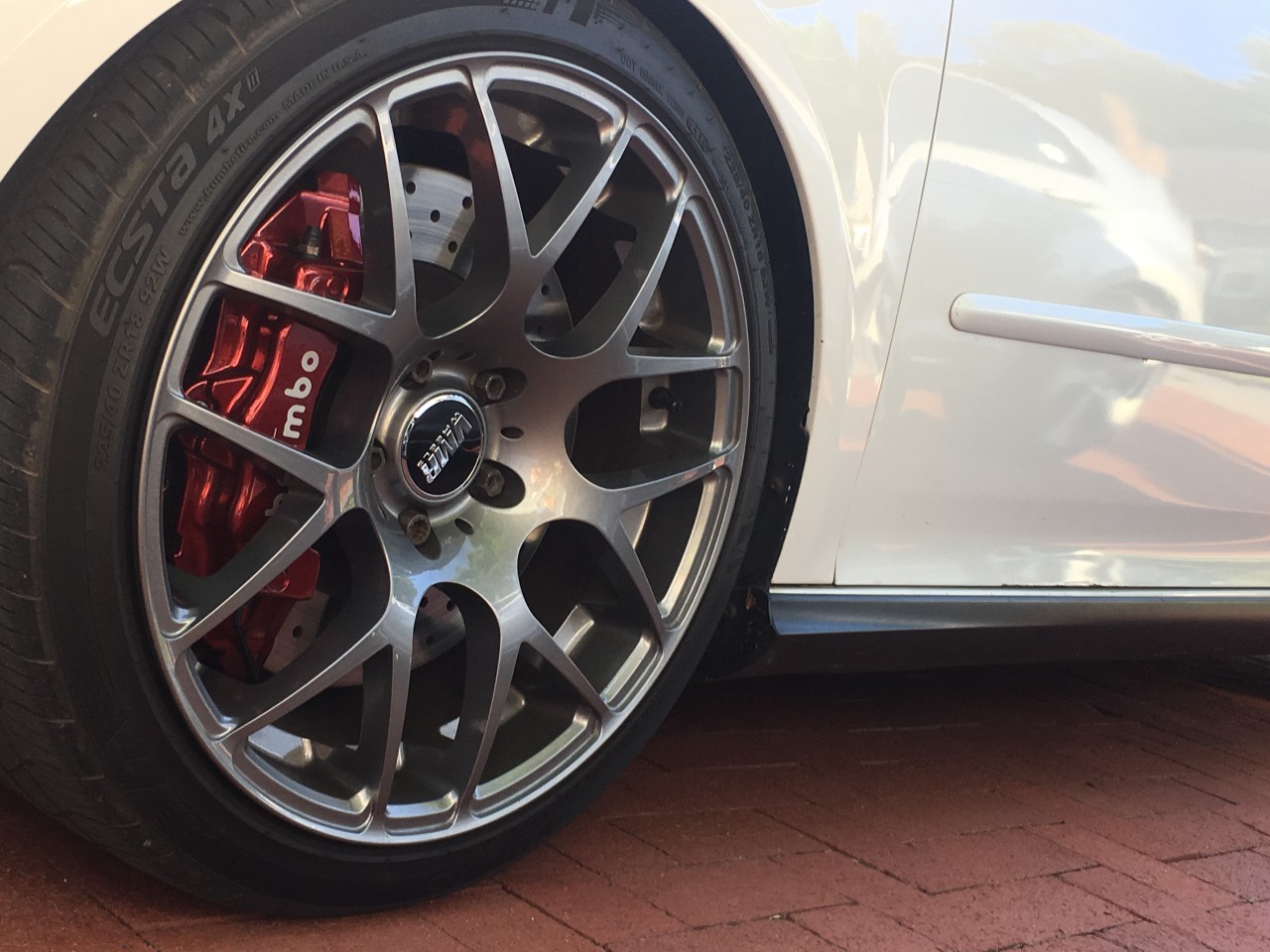
The calipers I purchased from car-part.com and Ebay. The shipper from car-part lost one of the calipers in the mail, so definitely be weary of buying stuff from car-part, but it is cheap and the caliper was extremely solid.
Calipers - Brembo 18ZL and ZR, totaling approx. $360 shipped.
Rotors - Mercedes GL450 rotors, get them in any flavor you want. DB-35091 From Brake Performance were mine.
Lines - StopTech Braided Stainless Lines - PN 950.33013
Mounting Hardware - ECS Stage 4/5 Mounting Hardware - PN 009759ECS01KT
Rebuild Kit - 30mm/34mm/38mm Stoptech/Brembo Front Brake Caliper Rebuild Kits (Qty 2) 18Z - Ebay Item # 263562711094
(I had been sent one wrong dust boot and they quickly sent me a full second set, Ohio Performance Solutions was definitely a pleasure to deal with)
Pads - Brembo ceramic brake pads P/N 7L0698151P
Pad Hardware Kit - https://audibbkparts.bigcartel.com/p...r-hardware-kit (You can also shine up the hardware that comes on your brakes, but I wanted some nice new hardware)
Hub Centric Rings - Vw Golf Mk5 GTI Hub Centric Aluminium Rings 65.1mm to 67mm when using GL450 Disc - Ebay item #111392994828
***WILL NEED SPACERS! Your stock wheels will not fit under these brakes! I am using VMR V710 18x8.5 ET45 wheels and the 18zs fit under these wheels without any spacer needed. I cannot guarantee your wheel will fit! ECS tuning has a great sizing template for their stage 4 BBK to check if your wheels will work.***
Other items not required but definitely help:
Upgraded Aluminum Lower Control Arm Kit - With ECS Polyurethane Bushings - PN
017047ECS01-02
These allow for caliper clearance with the control arm at full lock. The standard welded steel arms we have on the MK5/6 are quite tall and will hit the lower part of the caliper at full lock. Simply grind a bit off of the control arm if you'd rather not do the aluminum arms, but they are a great upgrade!
So here was the first caliper I received. The first think you will notice (and I still haven't quite gotten used to this) how absolutely massive these calipers are. For what they are, a cheap BBK, these are works of art. Die-cast, anodized and painted silver with six pistons 30/34/38 mm in diameter featuring phenolic caps that insulate the pistons and brake fluid from rotor heat. I can say after some decently hard runs on Angeles Crest Highway in CA, the calipers don't even heat up. It's very weird, they're always room temperature unless you're actually lapping a track all day.
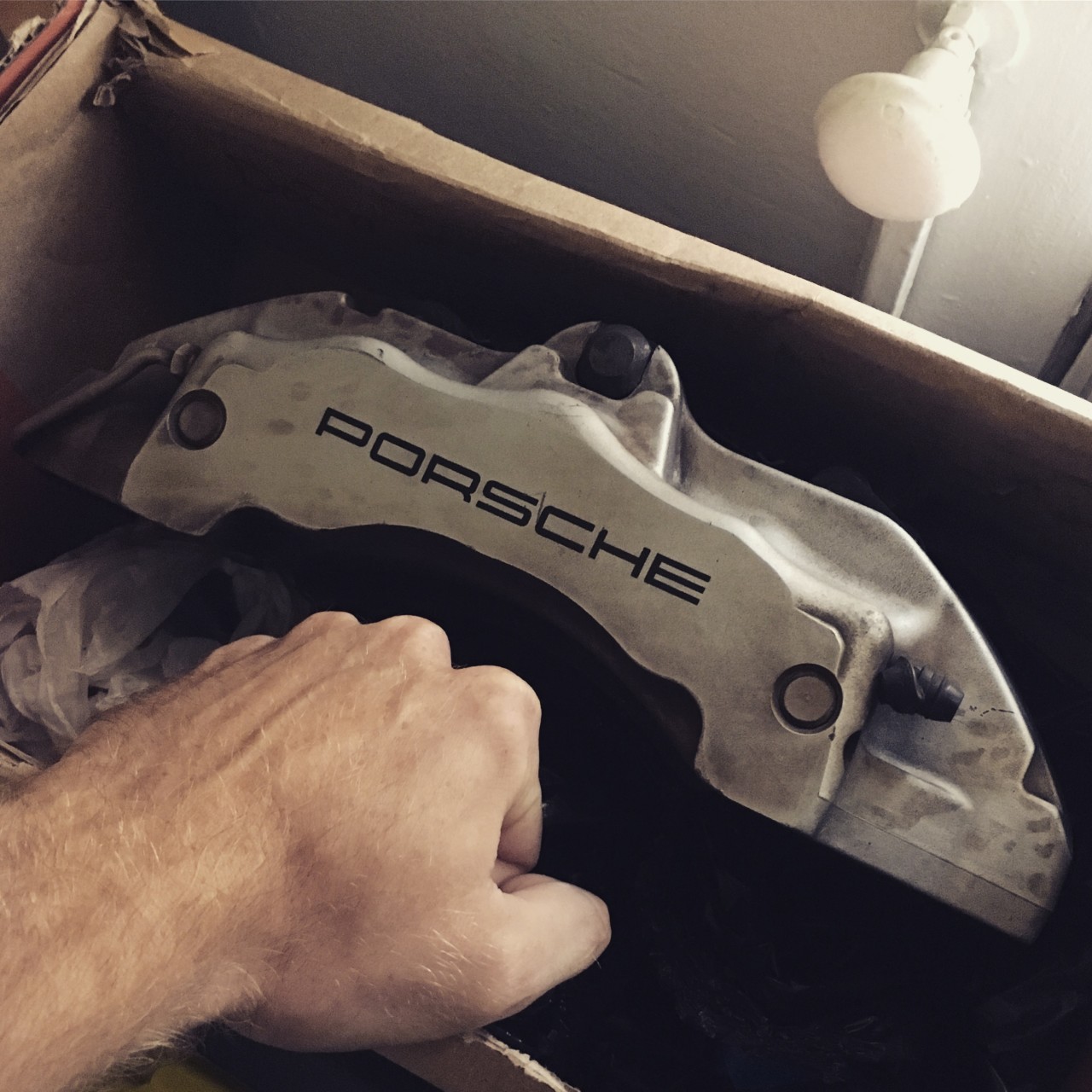
(Fist for size comparison)
These calipers aren't heavy, either. They are comparable in weight to the original GTI calipers, and definitely lighter unloaded. The rotor is what gets you, weighing in at 29.5lbs, up from the 18 lbs of the standard GTI rotors. That's quite a bit, which is why I highly recommend purchasing the ECS floating 2-piece rotors from the stage 4/5 kit given that they weigh the same as our standard rotors. There are a few other reasons I highly recommend these which I will mention down the road.
Here was the first mockup test under my wheels over the standard rotors, which in comparison are tiny. These were mounted with the ECS Stage 4/5 brake hardware kit.
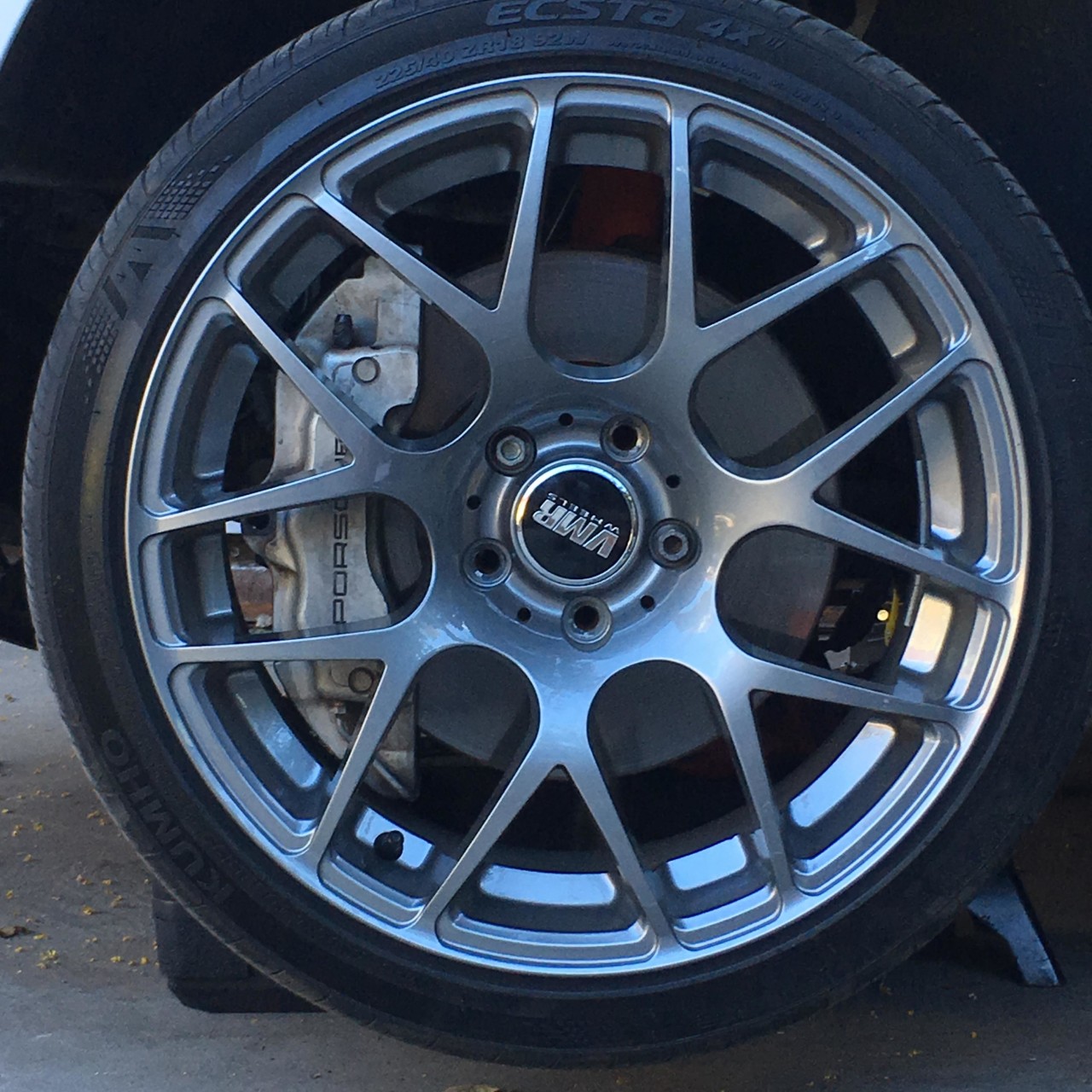
You will notice just how wide these calipers are, it's a bit ridiculous. I have about 2mm of caliper-to-wheel clearance, which for the past 8 months has been perfect with no contact to the wheels. I was convinced this would be fine when I visited a Subaru dealership, looked at a brand new STI with 6-pot brembos, and noticed the caliper-to-wheel clearance was seemingly less than my current setup. I had no calipers to measure, but they were VERY close to the wheels. Even though there's a recommendation of at least 3mm spoke-to-caliper, I have found that where I'm at with these calipers is just fine. Keep an eye on your wheel bearings of course.
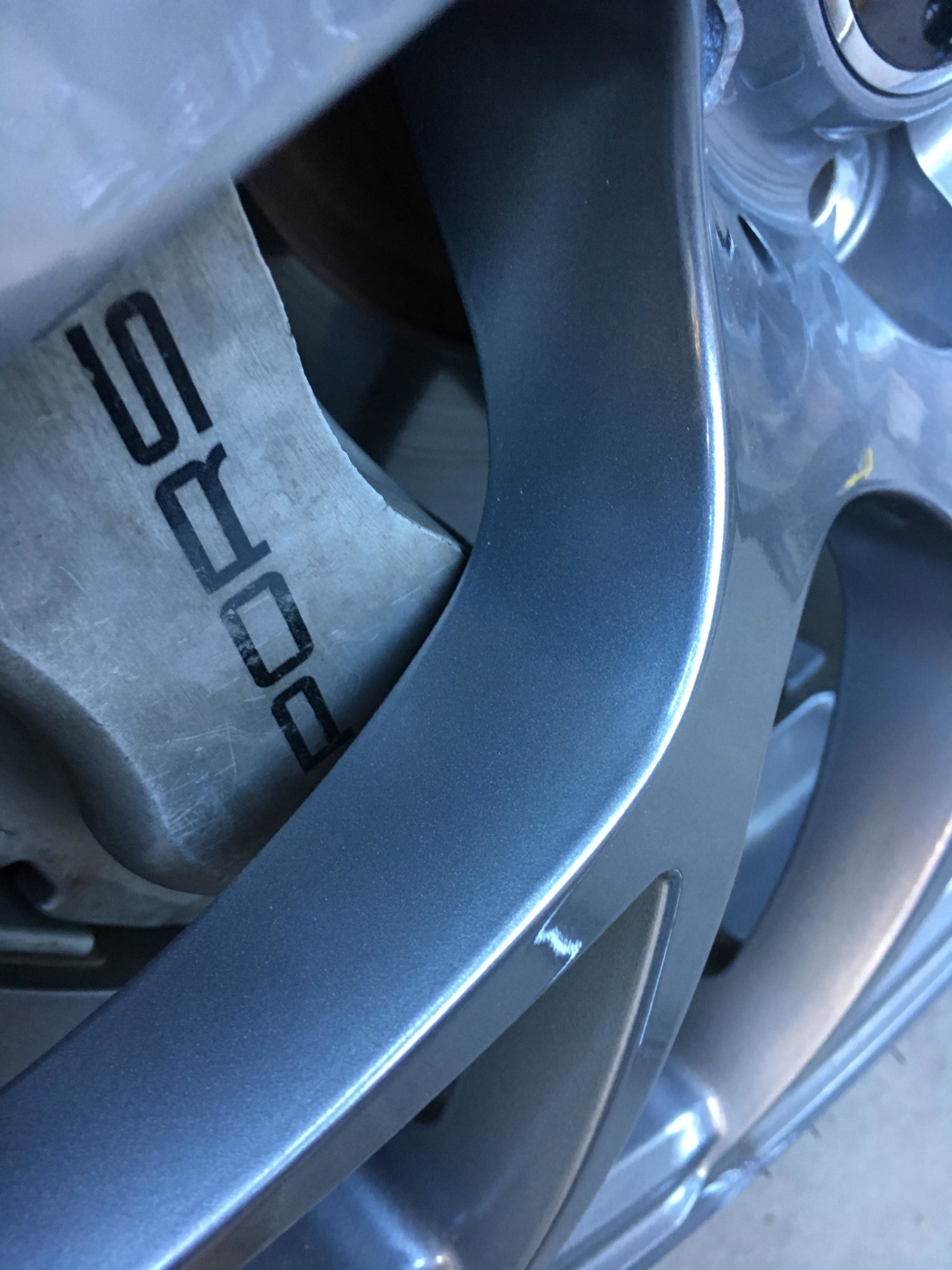
The first order of business for me was stripping the calipers, because I had decided after months of agonizing that I wanted to try powdercoating. I'm very stubborn as well, so I decided for about $400 I could have a bit of amateur powdercoating equipment and do both my front and rear calipers and be in some sort of control of the quality. This is by no means a professional job, but I really can't say that they look bad at all. I quite like how they look and it's far better and more glossy, candy-like than anything I've ever painted before.
Info about painting vs. powdercoating
I spent about two months fighting with myself, reading forums, asking opinions and going back and forth on what exactly to do and how to make these look great. Here is what I have learned thus-far:
Painting via rattlecan: This is a really, really cheap and pretty good looking way to color calipers. The huge benefit is that it is SUPER HARD to strip powdercoat, whereas stripping paint is very, very easy. Be careful, though, because the colors and finishes that you may want will likely be fragile if exposed to brake fluid. I had done a few tests with duplicolor metalcast and crystal acrylic clear, and brake fluid ate it straight off. It does not hold up to Dot4, no matter what the manufacturer tells you.
Painting via G2 caliper paint: If you want your DIY job to reek of DIY, try brushing but realize on calipers this big, brush-painting them is a constant losing battle. The first time I tried it, it looked like pure garbage, something like an arts-and-crafts project from preschool. If you go with G2, thin it and spray it through a gun, because that is the only way to rival powder coat or other nice painted finishes. The reason why I think G2 is still a good option is because of its durability and temperature resistance. When heating the spray-bomb metalcast paint in the color that I desired in the oven, the deep metallic red surface finish on my test piece quickly turned to a very burnt looking orange around 200 degrees surface temperature. I can say that without a doubt, G2 is probably the best option if you want to use the crap out of these calipers at the track. It was really, really hard to strip this stuff off the caliper after my failed brush-attempt. I can also say that it will be around $150-$200 dollars at least in paint for a whole set of brakes, because G2 is expensive and these calipers are huge. If you want decent coverage you will definitely need to make sure you have enough. I used two kits on my standard 944 brakes a few years ago and (at least on cast iron) the finish sort of didn't last to well, so keep in mind surface prep and thick coverage is very important with this paint. Color selection is pretty limited with G2 and if you want a custom color match, the price goes up astronomically
Automotive paint: This is an affordable way to get an extremely nice finish if you don't plan on abusing the crap out of your brakes and getting them really hot. You also do not have to compromise the factory anodizing that is underneath the factory paint on these brembo calipers, because sandblasting for powdercoat application will remove that layer. Keep in mind It's not super brake-fluid resistant but is easier to strip and repair than powdercoat.
Powdercoating: Not for track applications. Powdercoating, especially multi-step like the finish I tried (chrome base with candy red top coat) will produce a much thicker coating than actual high-temp caliper paint. This will insulate the calipers a bit and hold heat more. Powdercoat is a thermoset polymer (at least the powder I used) and will melt until cured and, in theory, not re-melt at 400 degrees again. However, as with powdercoated calipers used hard, hot brake dust has the ability to embed itself if the caliper becomes too hot and it could ruin the look of your calipers over a long period of time if you really get them hot frequently. I know for a fact that my car is not a track beast and the reasons for doing this brake upgrade was simply for driving pleasure and a badass looking wheel and brake setup while also learning an incredible amount about my car and braking systems in general. To my surprise, even with spirited canyon road driving, I've never gotten the calipers even warm, thanks to those phenolic caps. So in my mind I viewed this as a great and long-term, durable solution. Keep in mind this is super NOT recommended by brembo for the reason that a. you will remove the factory anodized layer on the caliper and b. it can hold heat. I, however, wasn't too concerned as many people opt to powdercoat their calipers with great results and there is a lot known about the durability and great look of this method.
Ultimately, choose what works best for you. In the interest of trying to be "most correct", I learned over time that DIY jobs are DIY jobs and any method can work great for anyone if you put some time and effort in. I realized that if I wanted a metrically perfect brake kit I should just buy a complete new kit direct from brembo and end up paying 1/3rd the cost of my car, but I opted to try this cheap DIY method and it has exceeded my expectations!
Here's a shot of the caliper after the first round of sandblast prep - (note the G2 still stuck to it.. stuff is really hard to remove)
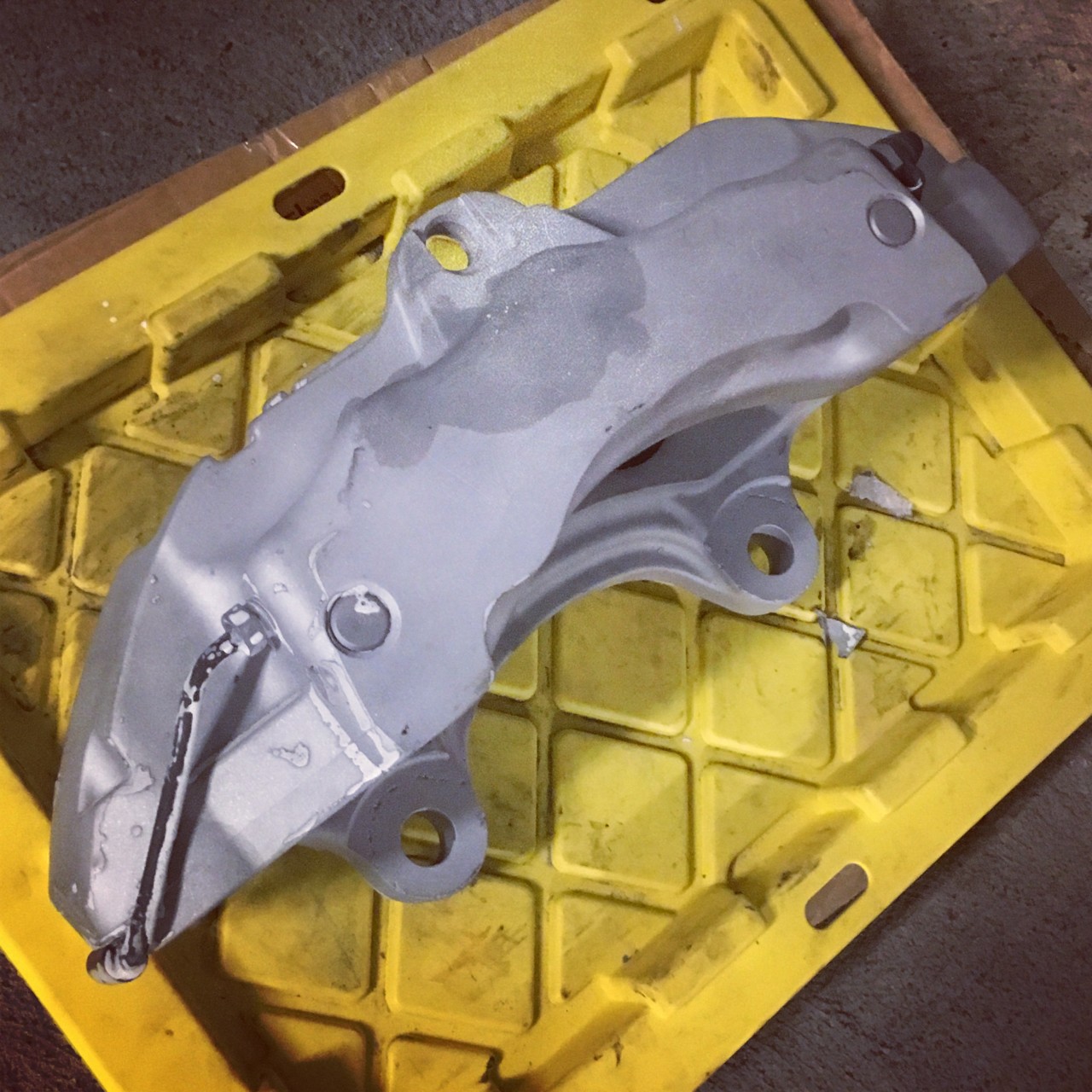
Here's a protip for protecting your calipers while refinishing them. I taped the old dust boots from both sides and wrapped that a few more times with tape. This makes a super tight seal to keep sand and anything else out of the caliper when you're working with it.
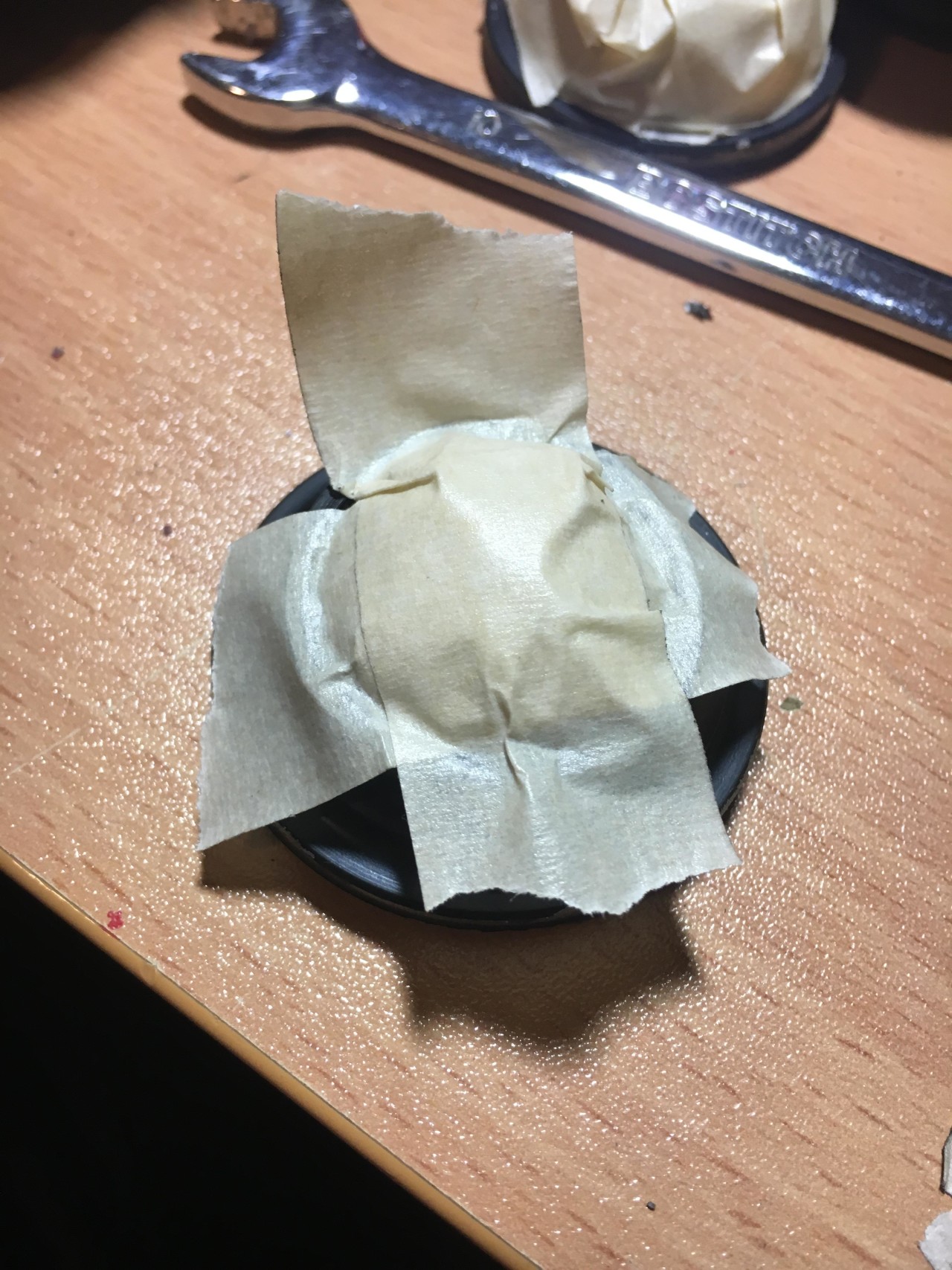
And, here's yet another tip for working with multi-piston calipers! In order to remove the pistons for sandblasting, I was puzzled when faced with how to remove them one-at-a-time. I've found some small C-clamps work great for holding the pistons in place when working them out. Simply release the clamp a very tiny amount and use compressed air to push the piston out more, bit by bit and one by one. Don't remove the pistons until they're all nearly fully extended and you can grab and pull them out. This will maintain an air seal so you can keep working each individual piston one at a time. Don't use a grease gun, it creates an absolute mess and I'm glad I used this method. As always, be careful working with air and pistons as they can really rocket out of the bore, but be mindful and keep your C-clamps adjusted close so you aren't rocketing the pistons into the clamps and cracking the caps.
(Please excuse the awful G2 brush paint job. I promise they get better. I had originally thought white would be nice but later went for the deep candy red to match the Golf Plus euro MK5 LED tail lights)
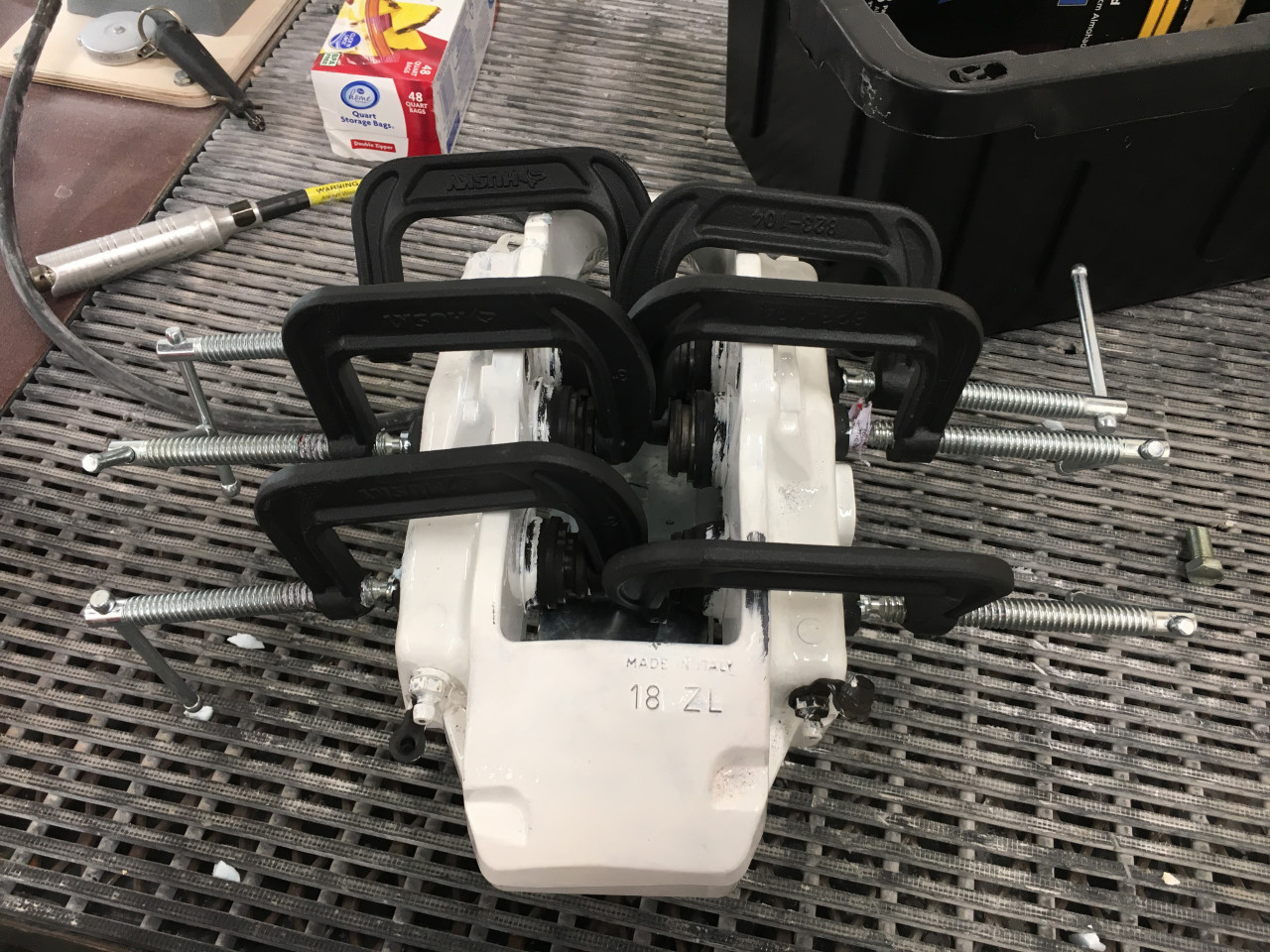
I'll get into the powder coating phase next -
Here's a list of stuff you will need if you want to do this! It was actually a very fun process and sort of easy, albeit nerve-racking.
-Eastwood dual voltage powder gun
-Toaster oven from wal-mart. Bought the largest one I could find there.
-2 gallon air compressor off amazon. The thing worked great for me.
-Lots of Grease/wax remover
-Alcohol for the grease-wax remover cleanup
-Silicon plugs and high-temp masking tape (easy to order this as a bundle from eastwood when you order the gun)
-IR heat gun for checking surface temp
-LED headlight to check coating thickness
-powder (prismatic powder was where I got the powder from. It's awesome stuff)
-DUST MASK (preferably a full face respirator)
-Extremely well ventilated area (Outside can work too, but the powder can make a mess so make sure to sweep up periodically)
(I used a ventilated area next to a paint booth that sucked air through filters which I could clean later)
Here are the steps you want to take:
1. Thoroughly sandblast the part. Make sure it is extremely, EXTREMELY clean. The caveat with powdercoating is that any sort of surface contaminants have the ability to release gas when heated and bubble the powder coat as it melts. You must make sure the part is very, very clean.
2. Use grease and wax remover for about five rounds, then use it again even when you think it's clean. Wear gloves for this process so the oil from your skin does not transfer to the part. I was satisfied with the cleanliness of the part if I could wipe a paper towel across the entire surface area of the part and it was still as white as a new towel. Use denatured alcohol for a few rounds to remove as much as the wax/grease remover deposits as possible.
3. off-gas the part - I off-gassed at 400 degrees for at least as long as I was planning on heating the part, which would be for about 20 minutes once 400 degrees or higher is reached. (Two coats, 10 minutes per coat) The longer you off-gas, the better. This will burn impurities out of the pores of the casting so that they do not cause bubbles in the powdercoat. I could really smell it the first time I off-gassed the parts. It's better to off-gas at higher temperatures and for longer periods of time, however with cast alluminum you run the risk of annealing it if the temperature exceeds around 600 degrees for an extended period of time, and in the interest of playing it safe I didn't push it too hard. This is by no means any sort of professional advice, I'm simply recounting what seemed to work really well for me in my little DIY setup. This of course was after reading for a while about powdercoating basics so as to make sure I can at least get it work.
4. After the part has cooled completely, ground the gun to the part, fill with powder and begin to coat. Keep in mind these calipers are honkers and the first round of coverage should be easy to achieve, but with the eastwood gun, any other layers (especially over a metallic base) will be very difficult to apply because the part is insulated. I used some braided steel cable and seated it in the bleeder holes running all through the interior of the caliper and plugged them in place with the silicon masking plugs in order to create a surface to clip the grounding clip to without affecting the exterior finish.
5. Place in oven and heat up to 400 degrees. I started the cure timer when the larger, beefier areas of the part reached 400 degrees and not the thinner, lighter areas. After the 10 minutes I opened the oven and allowed it to cool.
6. If you're second coating like me, this is where the challenge arises. You'll run into faraday cage effect zones on the part where powder just will not want to stick at all, especially with a cheapo gun like the eastwood gun. This is really advised against mainly because cure time can't be controlled well and you can very easy apply way too much powder, but I had to hot-flock the part at around 200 degrees. I'd wait until the part cooled to around 250, and by the time I had the powder changed out and the gun ready to go again, it was around 200-195 degrees. This is where the headlight came in really handy - I knew I had achieved sufficient coverage when the color was no longer a light pink, but a deep, deep translucent red. Since hot flocking involved the powder melting on contact as a means to get it to stick, you have to work very quickly and use the headlight to really study each surface and make sure you've got enough applied and immediately get it in the oven. After that, I followed the cure schedule of the powder.
Again, this is definitely a DIY job and not professional! Given the tools I had at my disposal and experience and eagerness to learn something new, I would advise that if you want your calipers to be absolutely perfect, just have them coated somewhere else with proper equipment. For my purposes though I thoroughly enjoyed trying this and learned a new process, and am quite happy with the results as they look on my car. This is great DIY equipment to have around to powdercoat other small things in the future and I already have other things I want to coat with the tools I have. It's not quite as daunting as people make it out to be but as with anything it is truly difficult to master and do it right every time.
I hit the character limit, so here's the second half -
Since I had never powder coated anything before, a friend donated to me a really crusty audi rear parking brake caliper to test with! Here are the trial steps of the process:
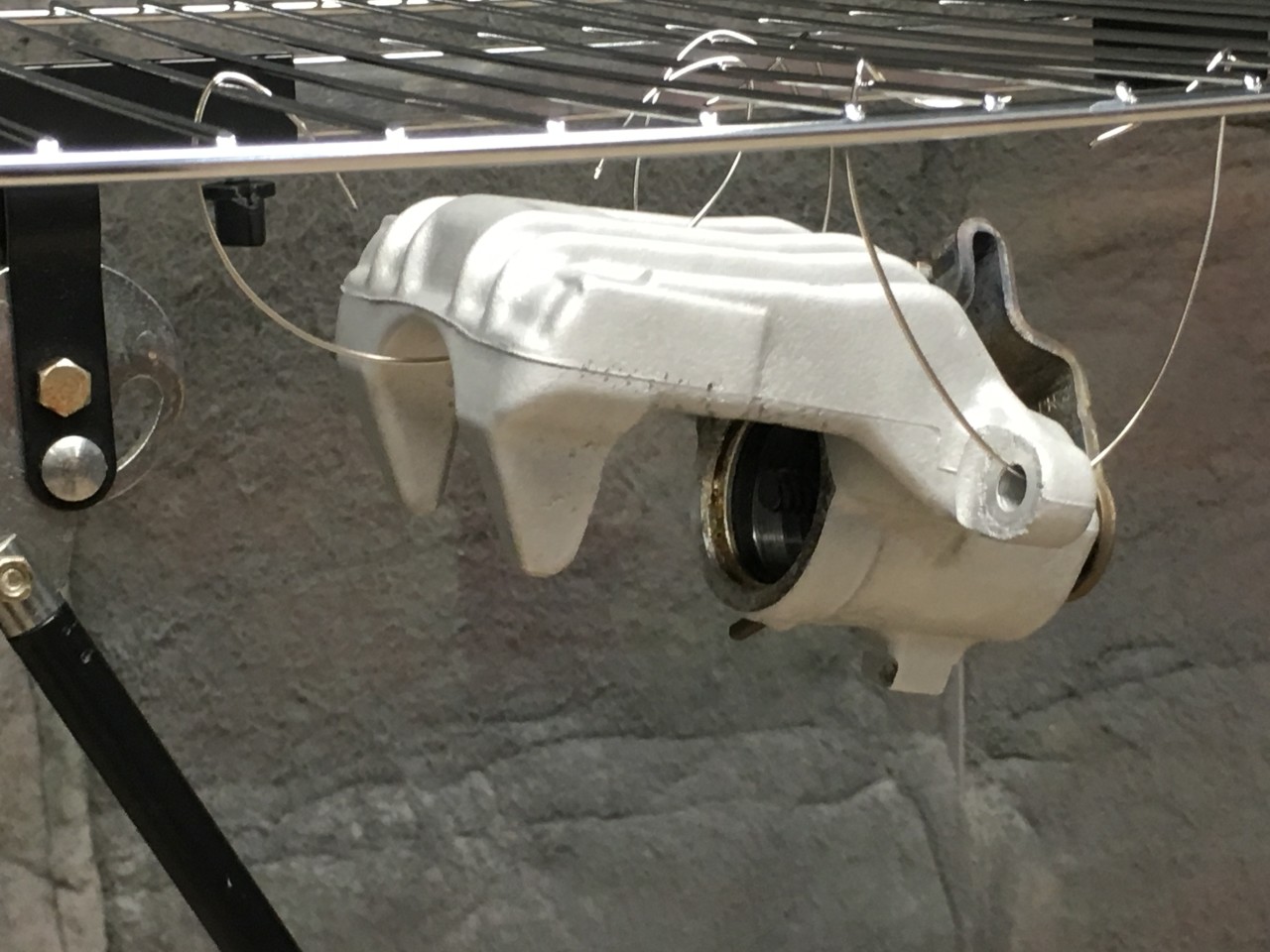
First layer of Super Chrome:
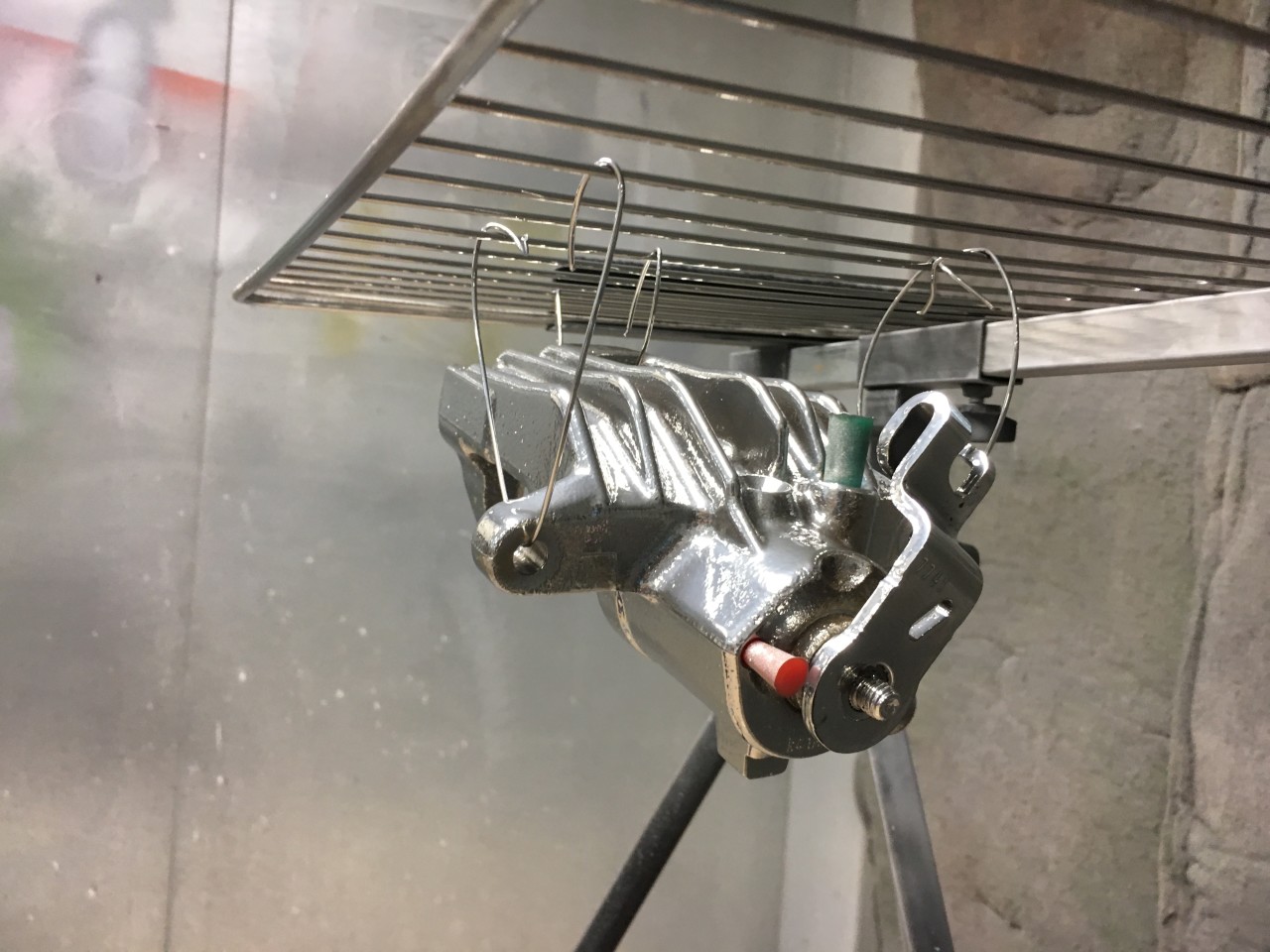
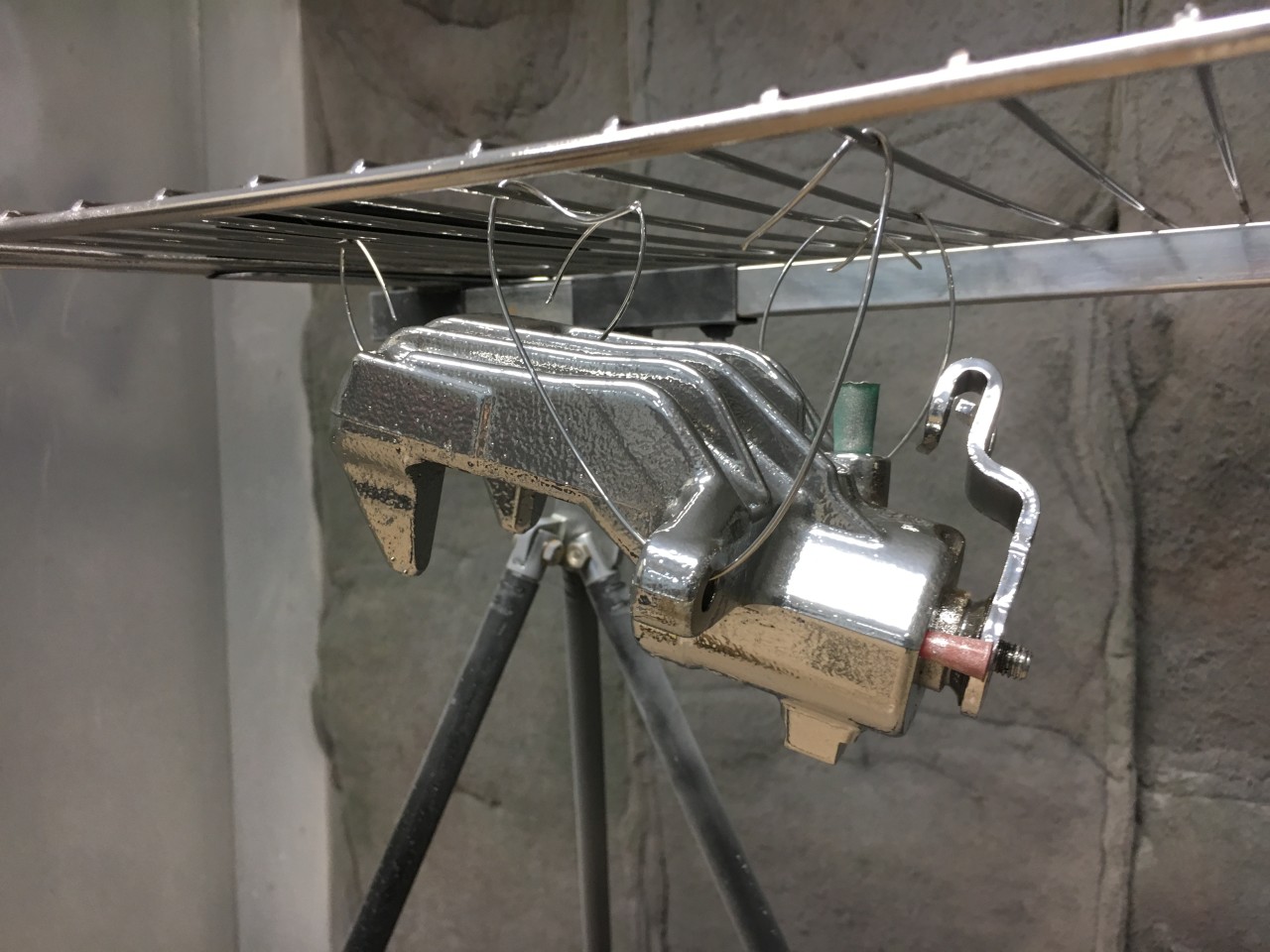
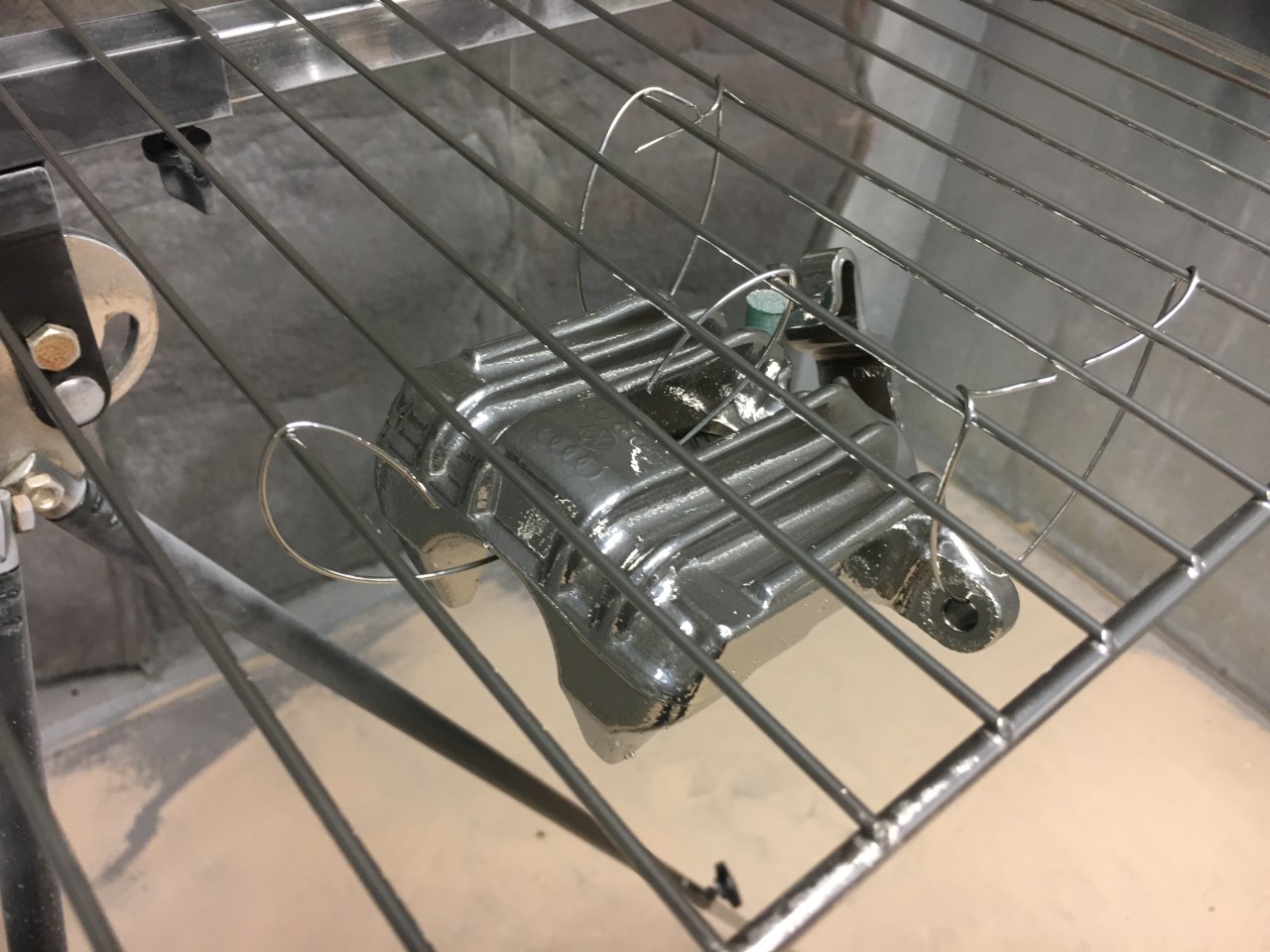
Second layer of Prismatic Soft Red Candy:
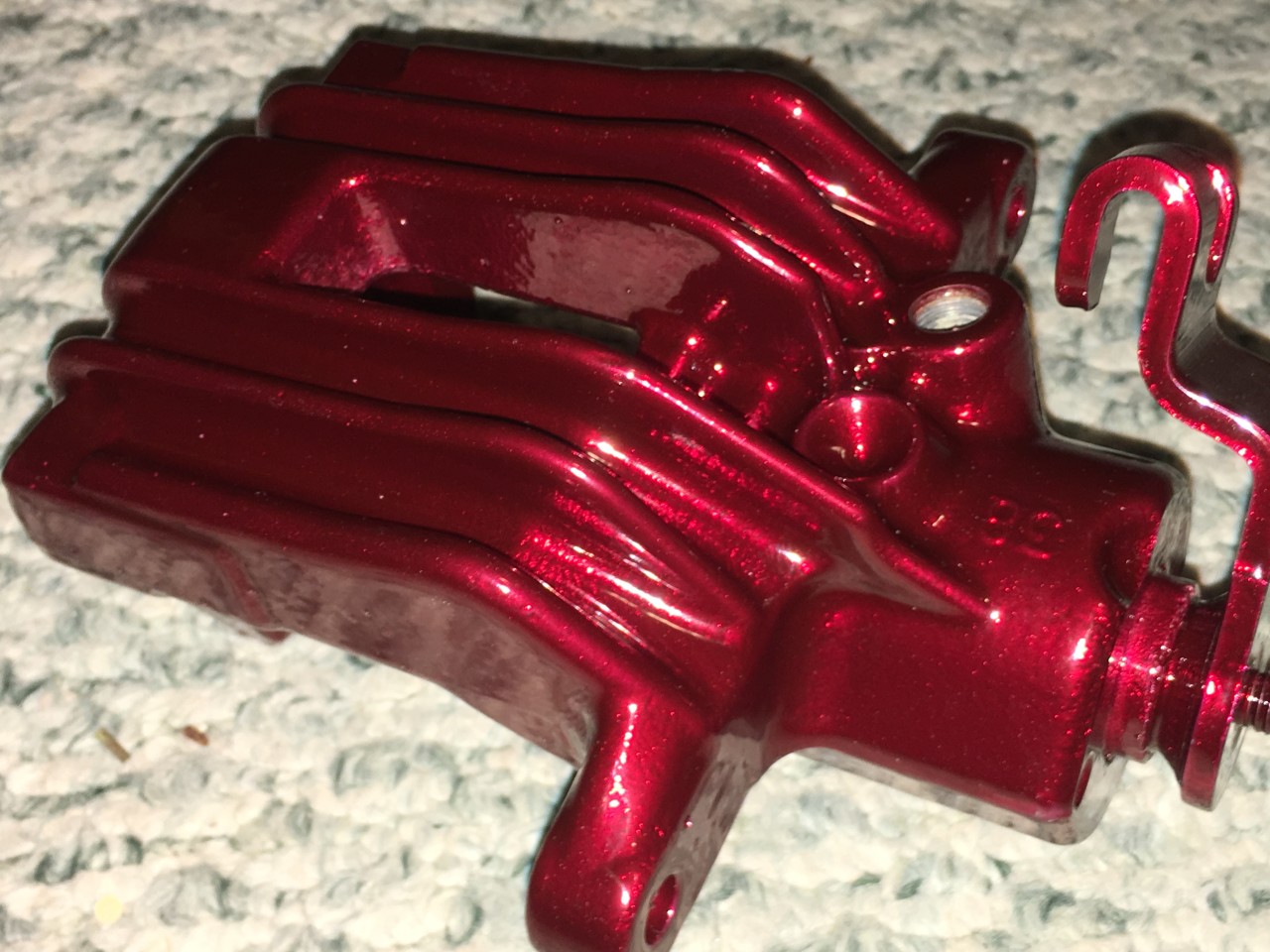
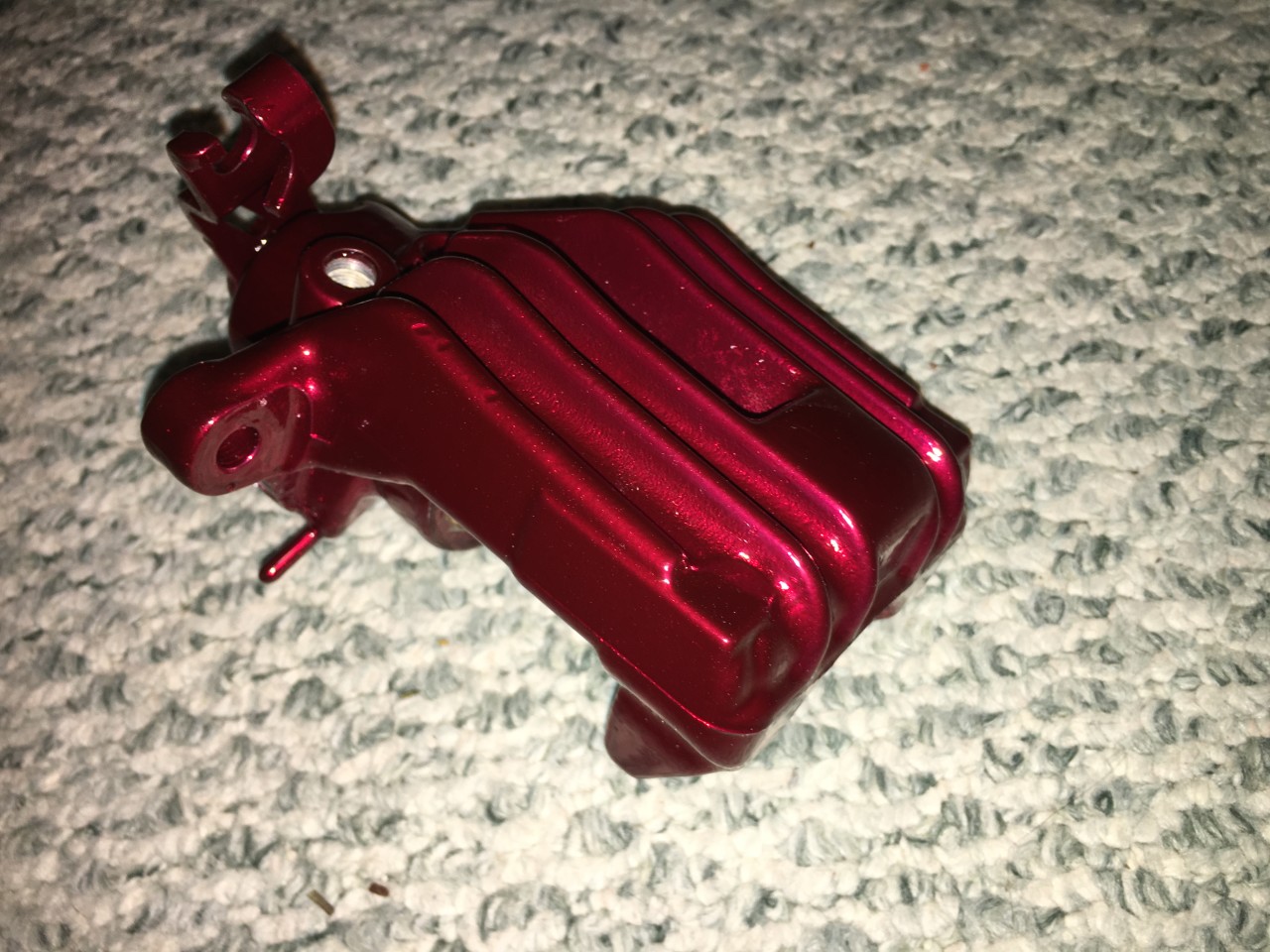
I was pretty satisfied with the finish on this test caliper and noted a few things I had to do better, which were cleaning the calipers more thoroughly and being more consistant with the application of each coat.
Time for the big ones! I was SUPER nervous doing these:
Here's the caliper all prepped and ready. I used the original dust boots, this time with some high-temp tape to mask the piston bores. I also made some mounting brackets to hold the caliper up using some L-shaped pieces of steel I found at Home Depot in the electrical section.
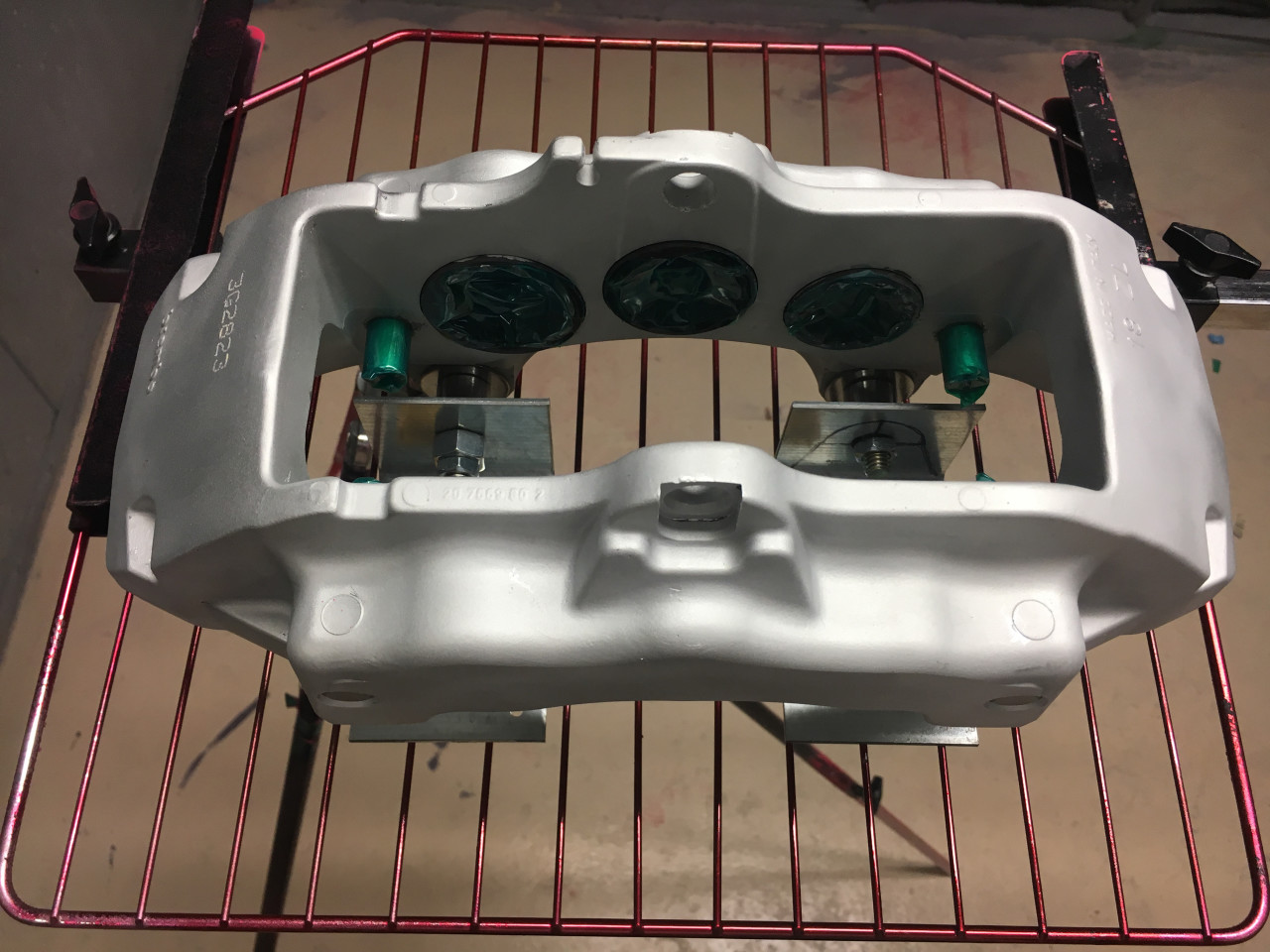
You can see the little Faraday cage areas near the pad retaining pin boss. There were a few select areas that I just could not get a decent amount of powder to stick, but ultimately it flowed out well and looked fairly consistent. This is where I started baking.
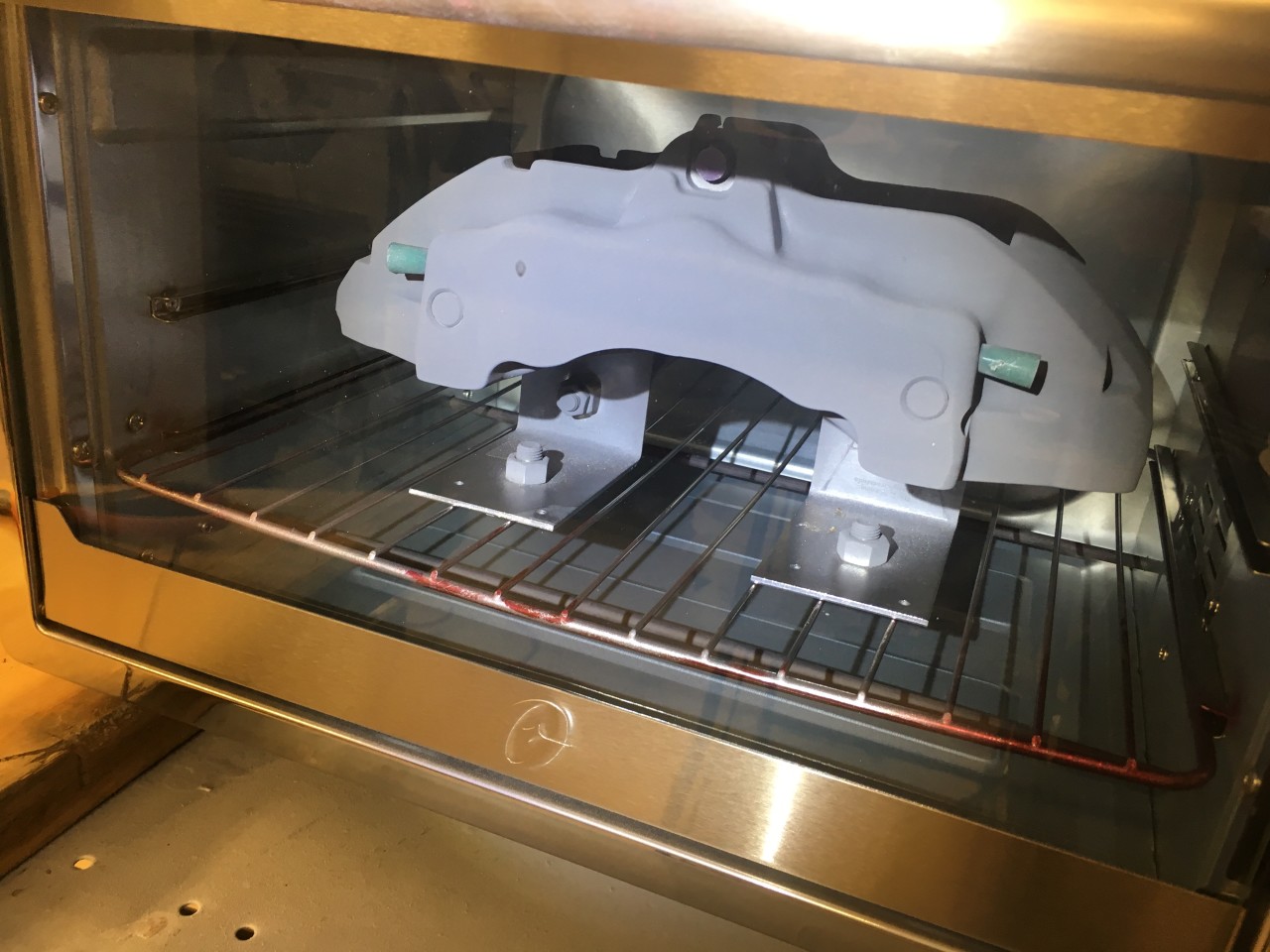
Flowing out! this was extremely cool to watch and turned out really shiny.
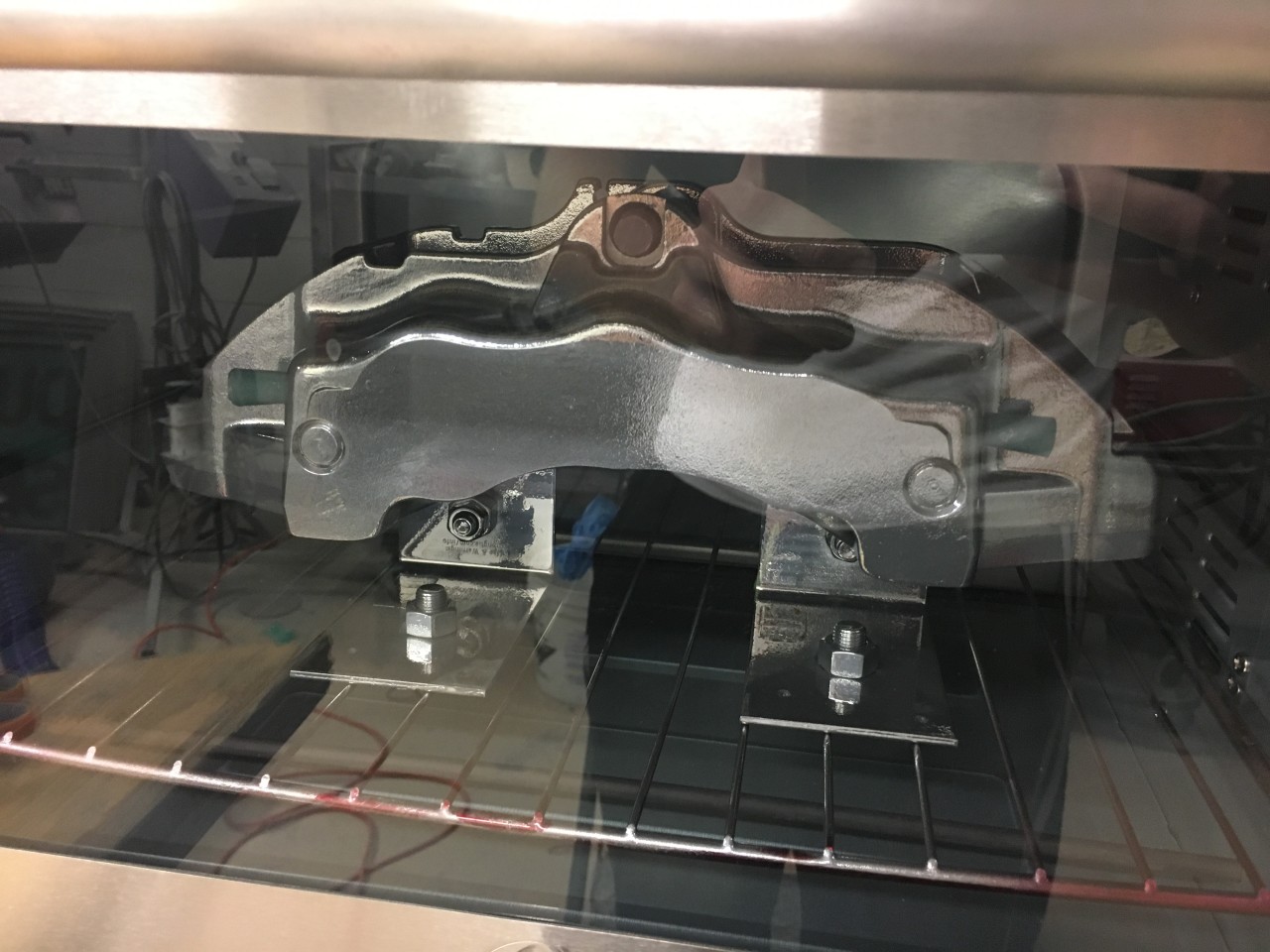
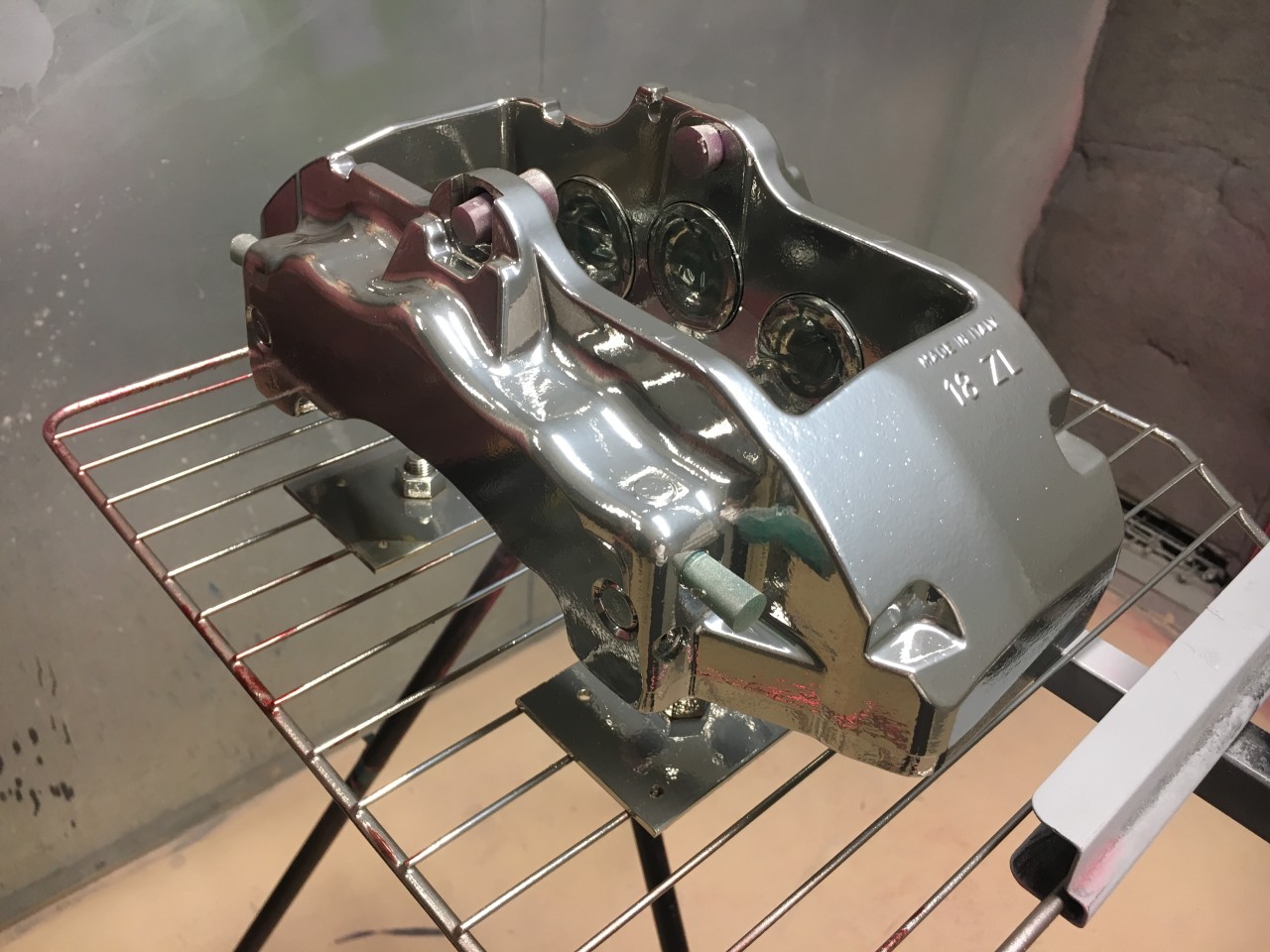
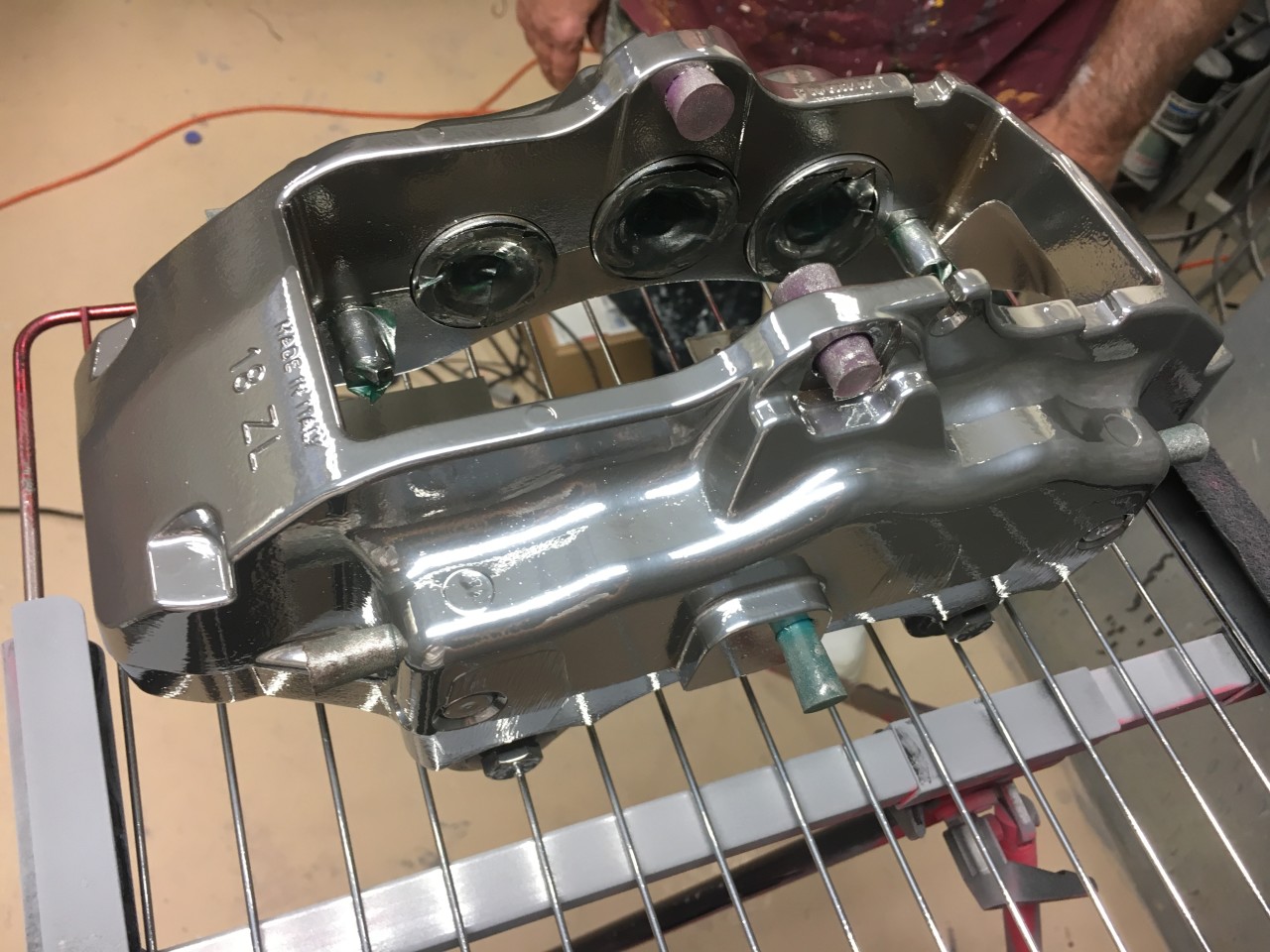
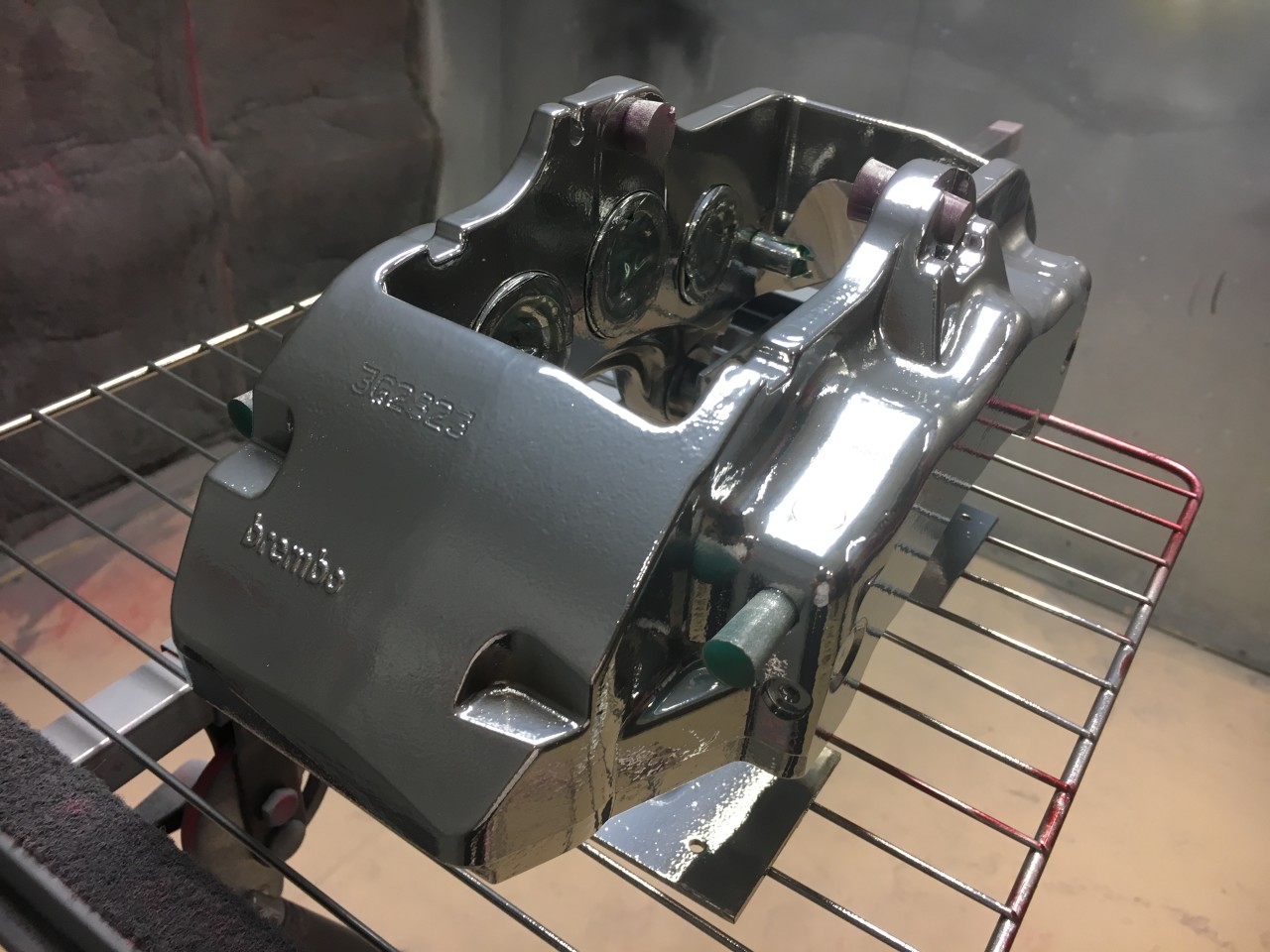
Next step was the Soft Candy Red. This caliper was so insulated by the super chrome base that I HAD to hot flock it. With the use of the headlight, it turned out quite well -
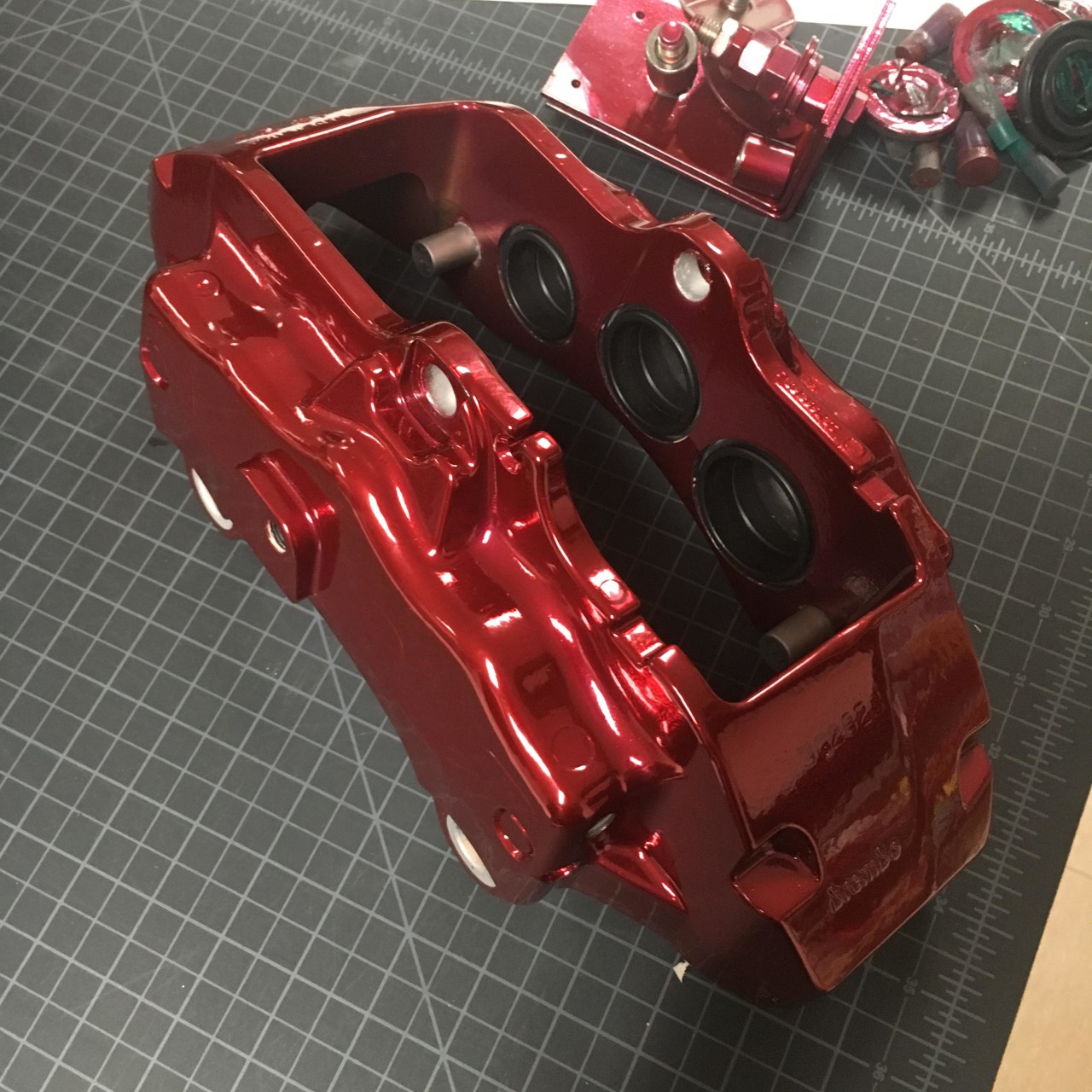
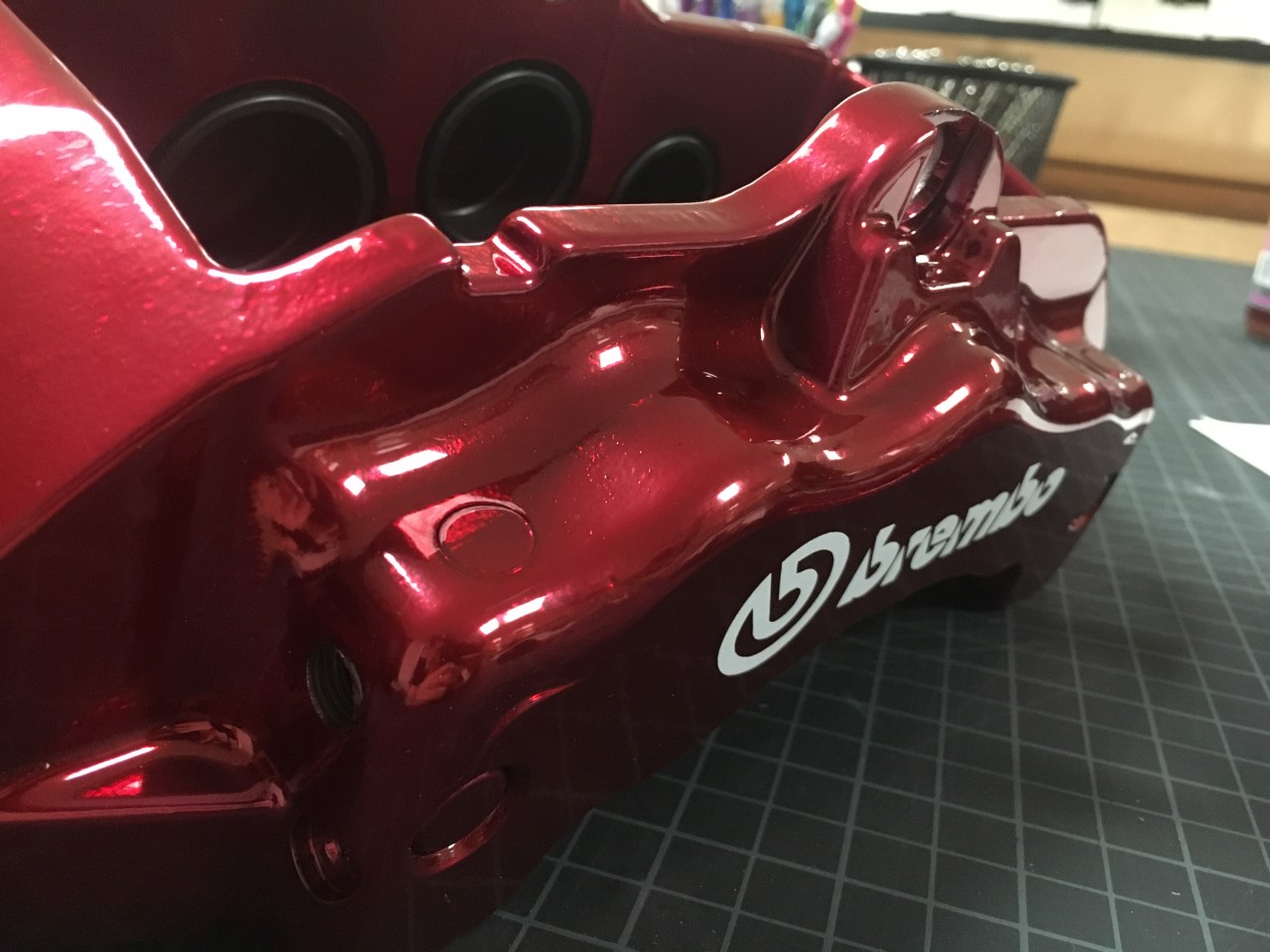
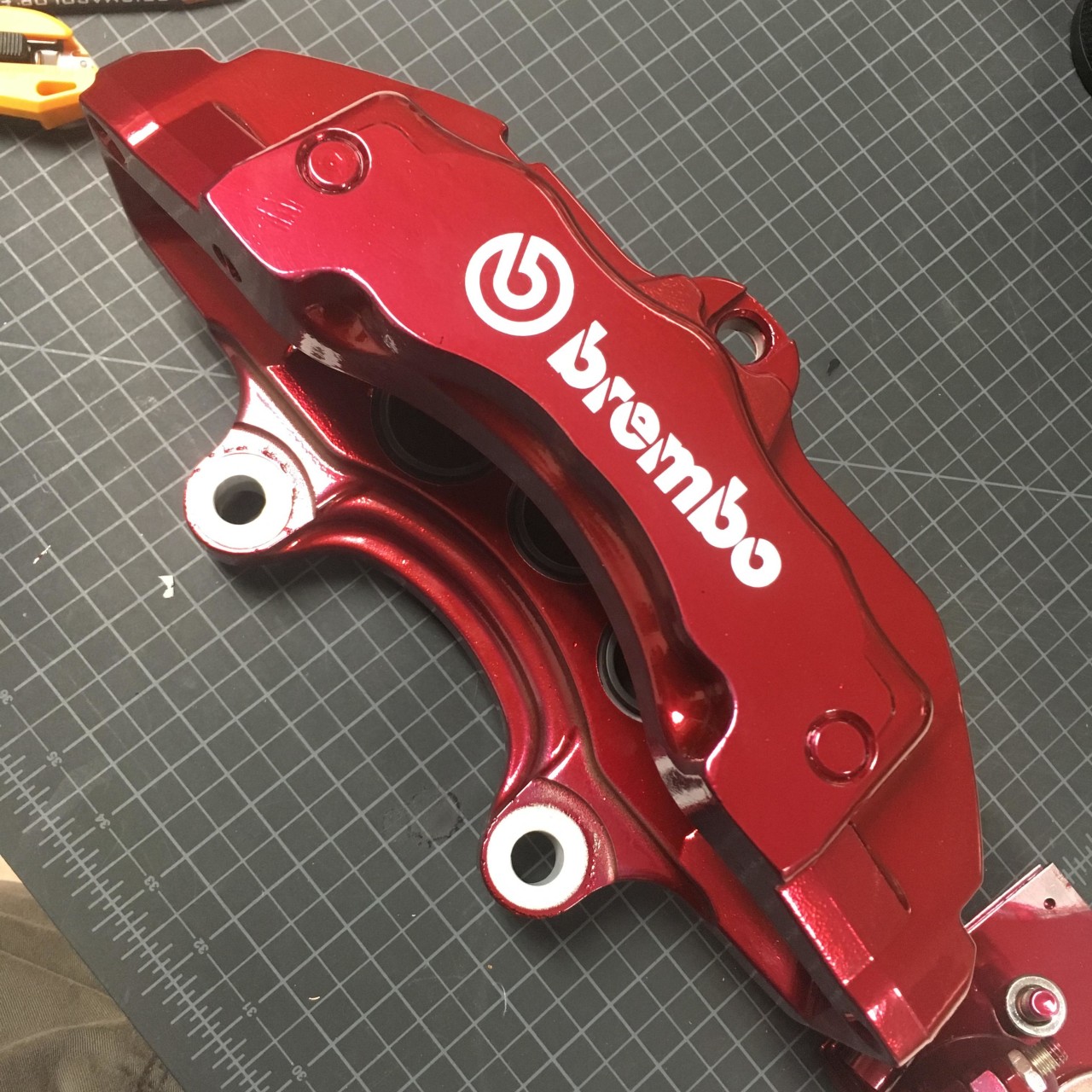
I had later decided to do something special with the logo - I was pretty drawn to the brembo logo that can be found on bike calipers and calipers that have been heavily machined - it looks to me like a tool path for a ball-nose end-mill made to cut the brembo logo into the caliper, and the directional arrow on these calipers I thought was a really cool touch, so I made a vector file in illustrator and had a friend cut me some stencils so I could spray-paint the logo on instead of use a traditional vinyl decal. I ended up liking this logo a lot more!
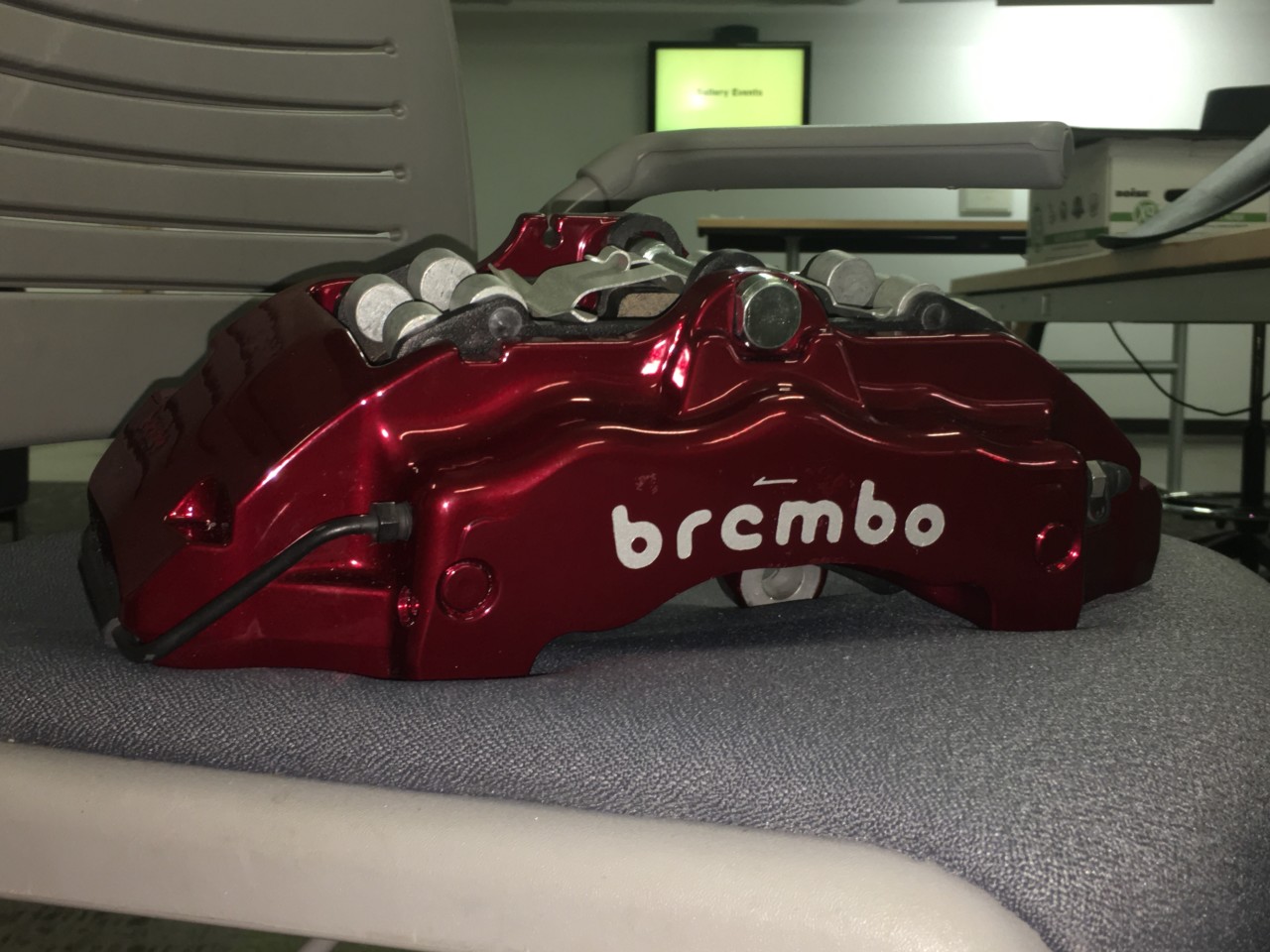
Here is one of the loaded calipers with the stock rear calipers coated as well. These were very tedious to disassemble and require snap ring pliers to be modified in order to remove the parking brake adjuster and seal deep inside the caliper:
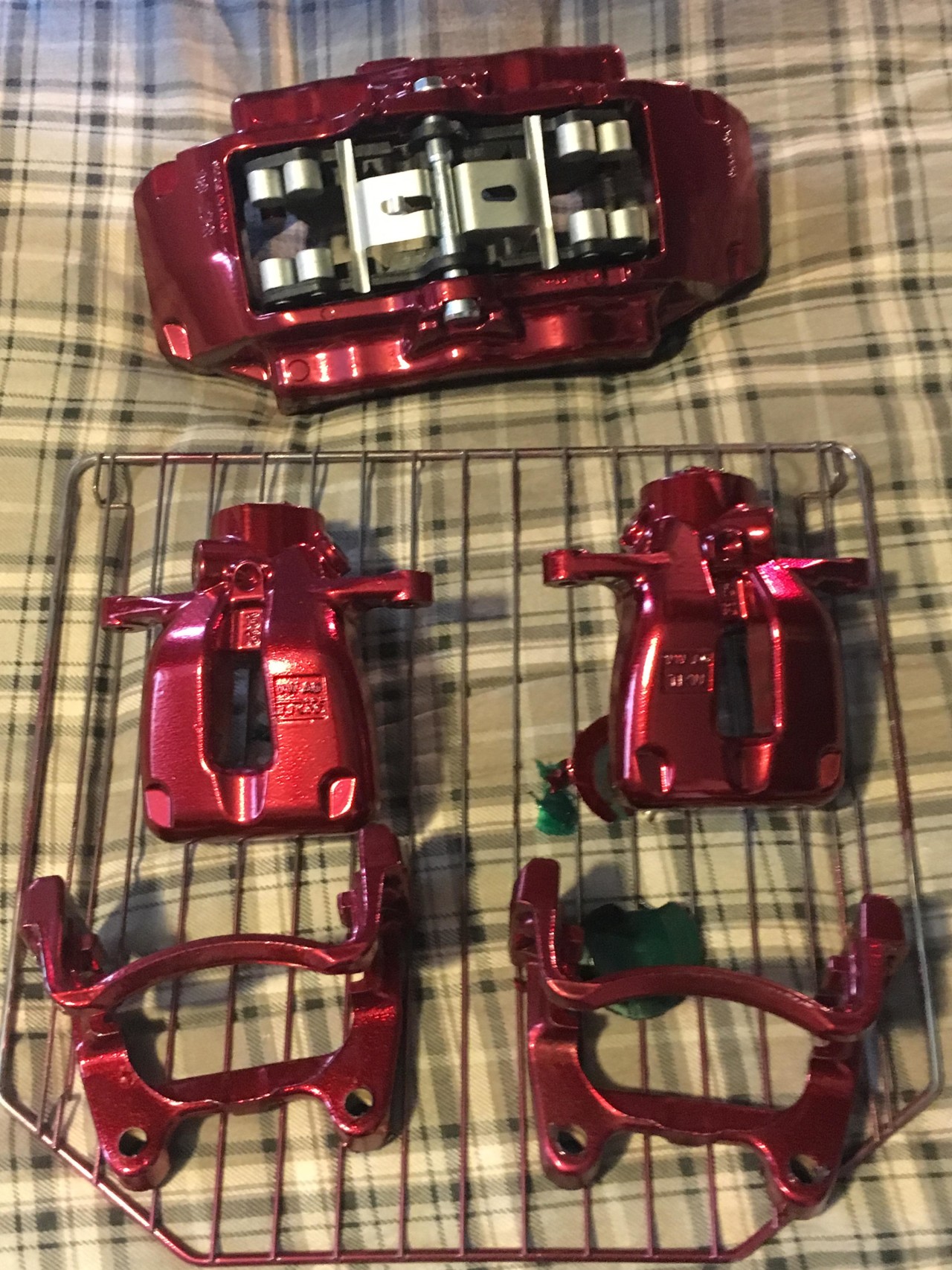
And of course, the final product!
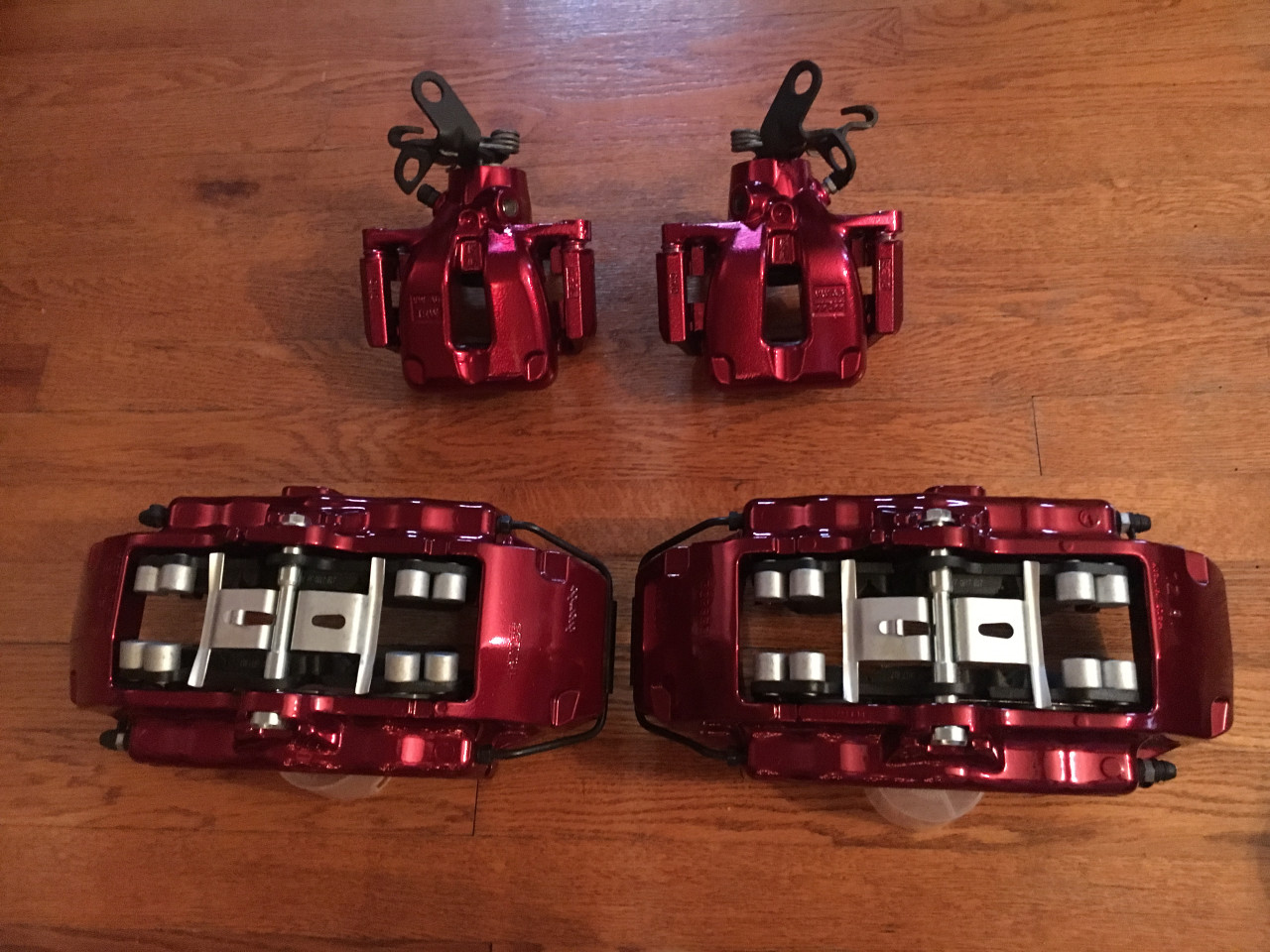
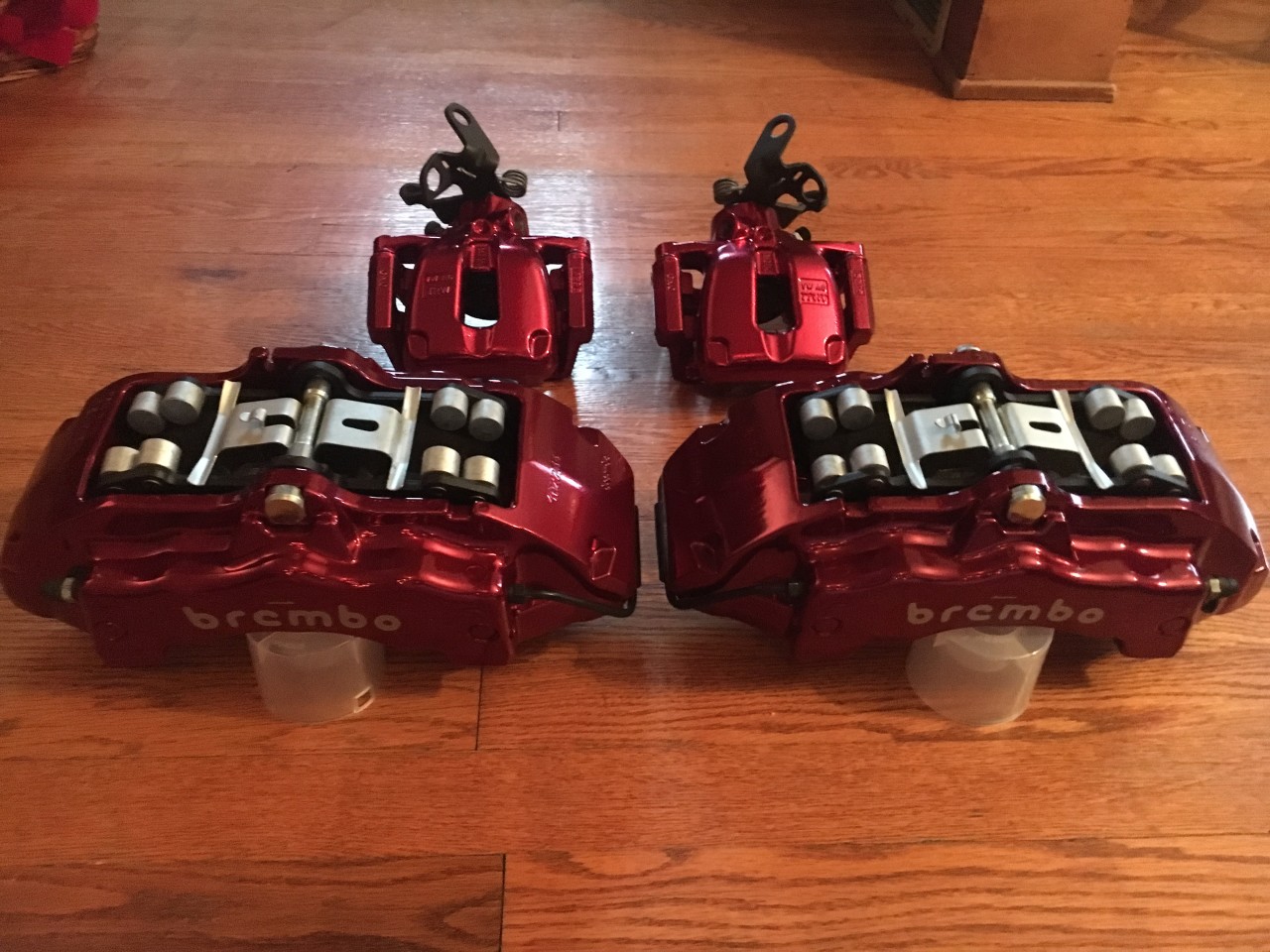
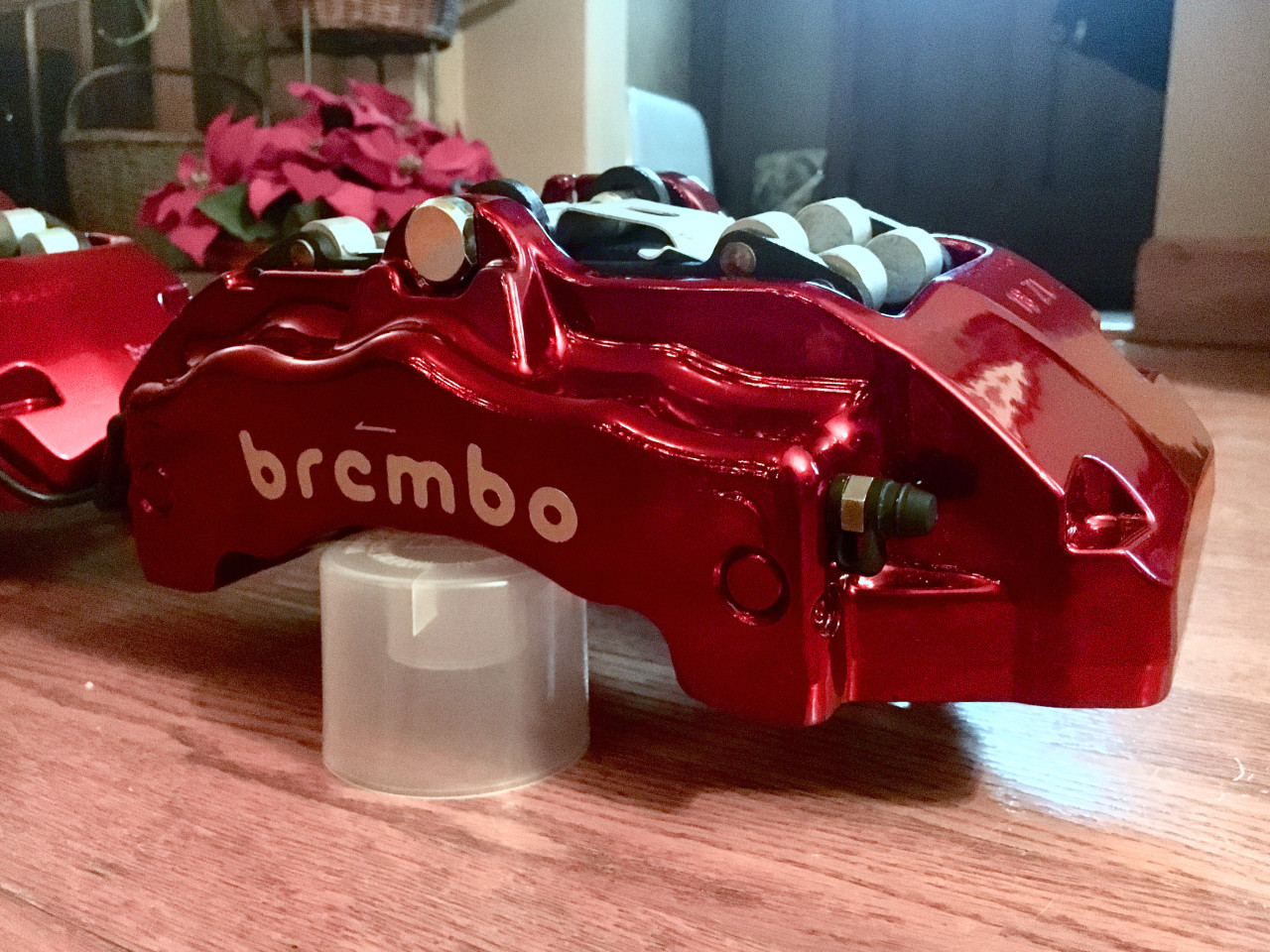
Installed on the car -
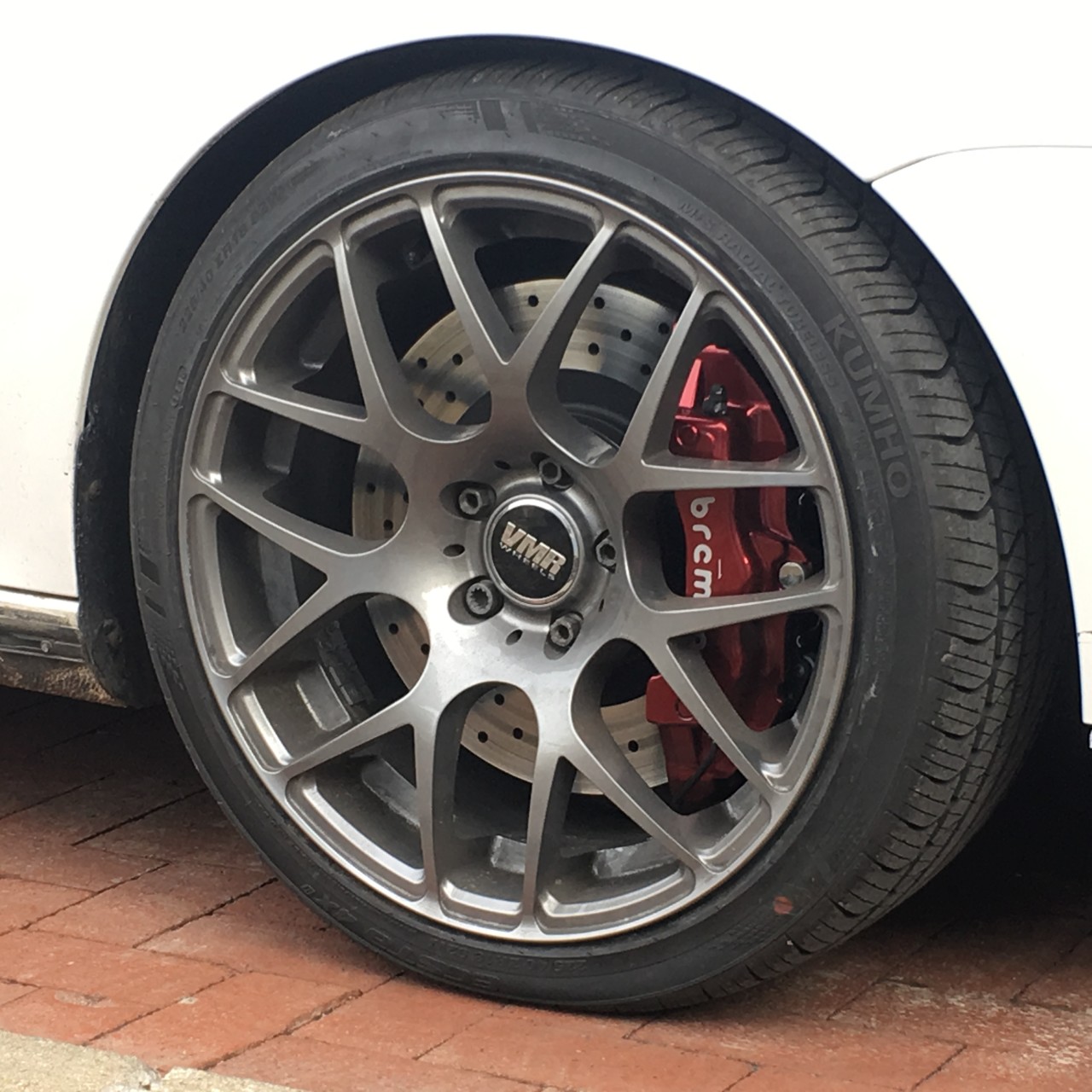
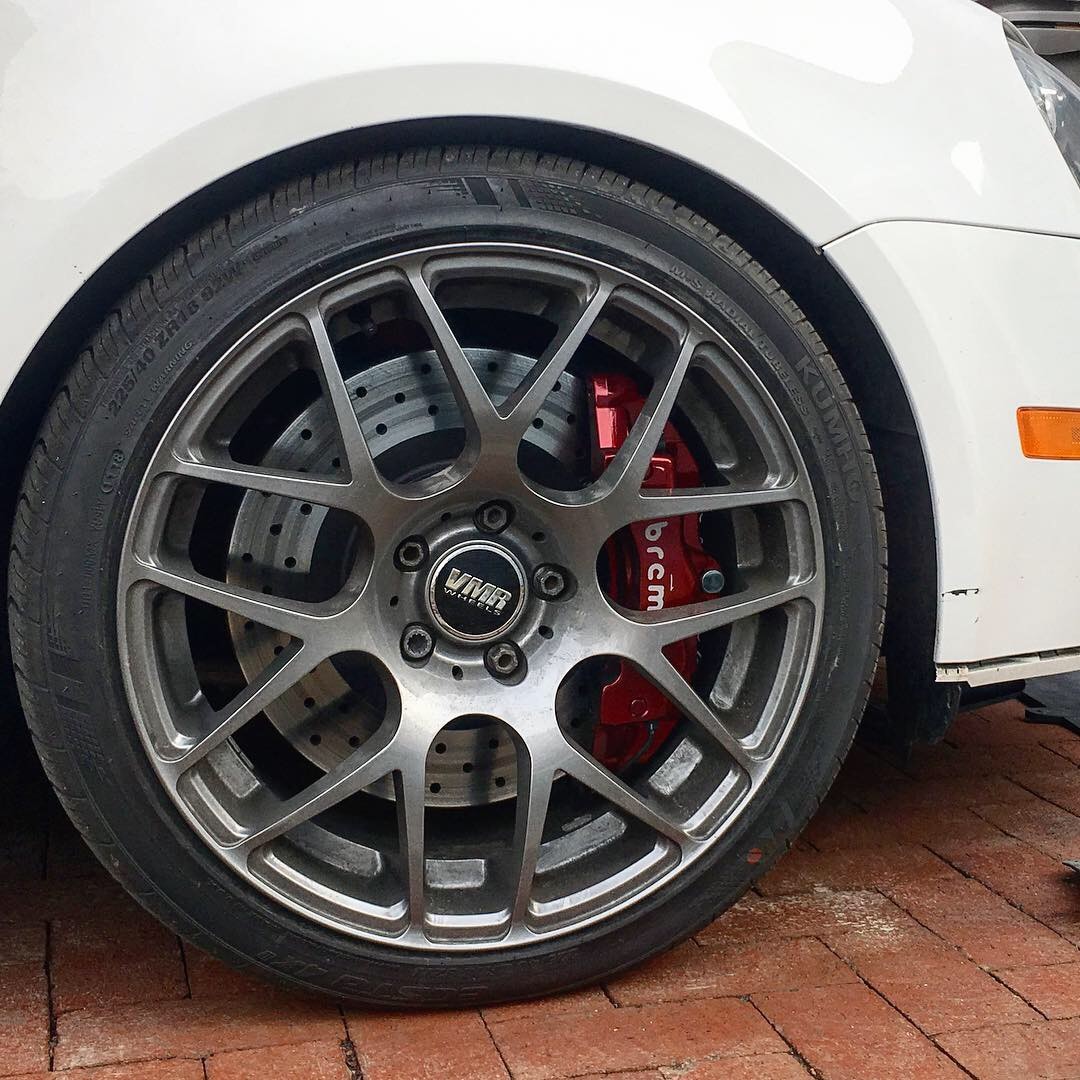
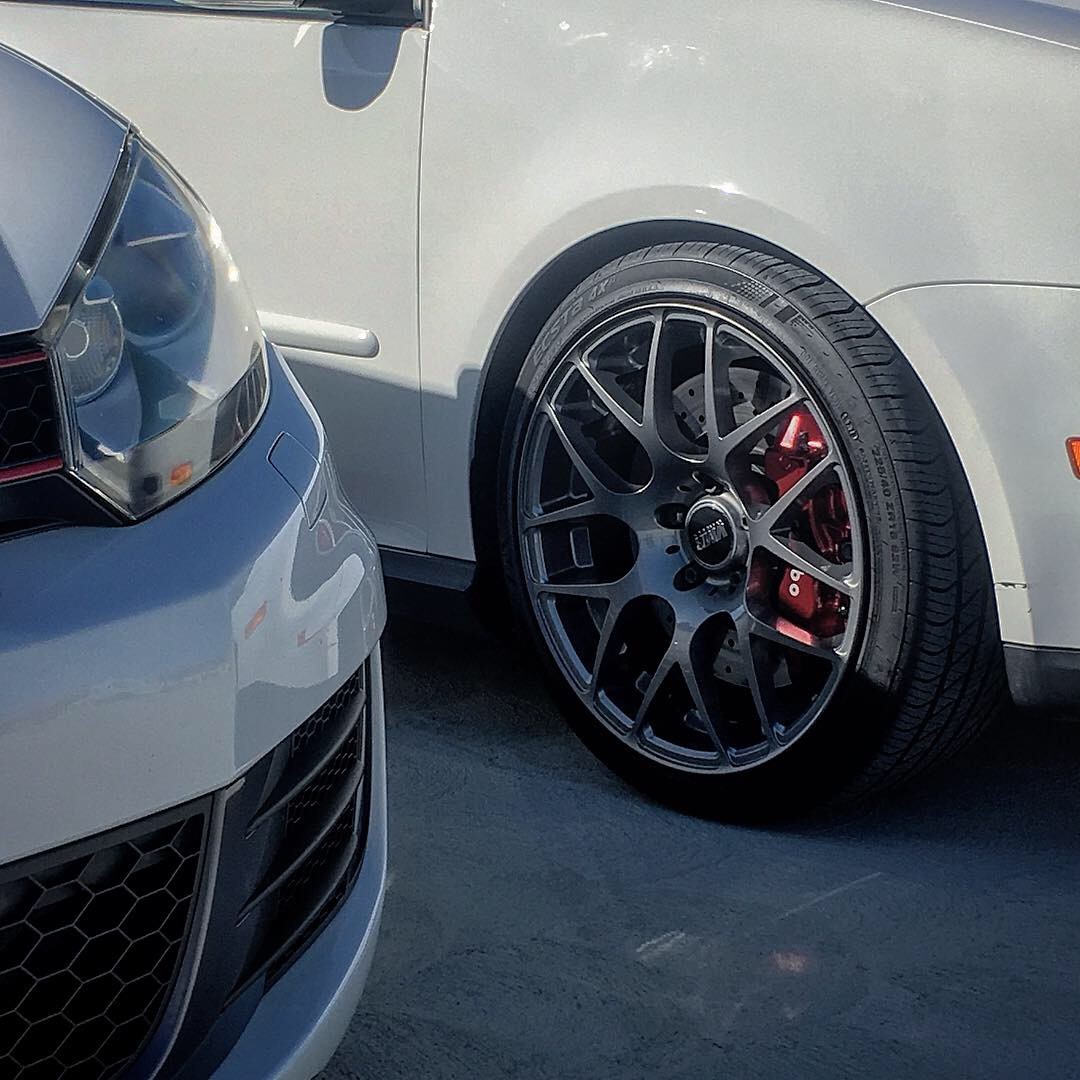
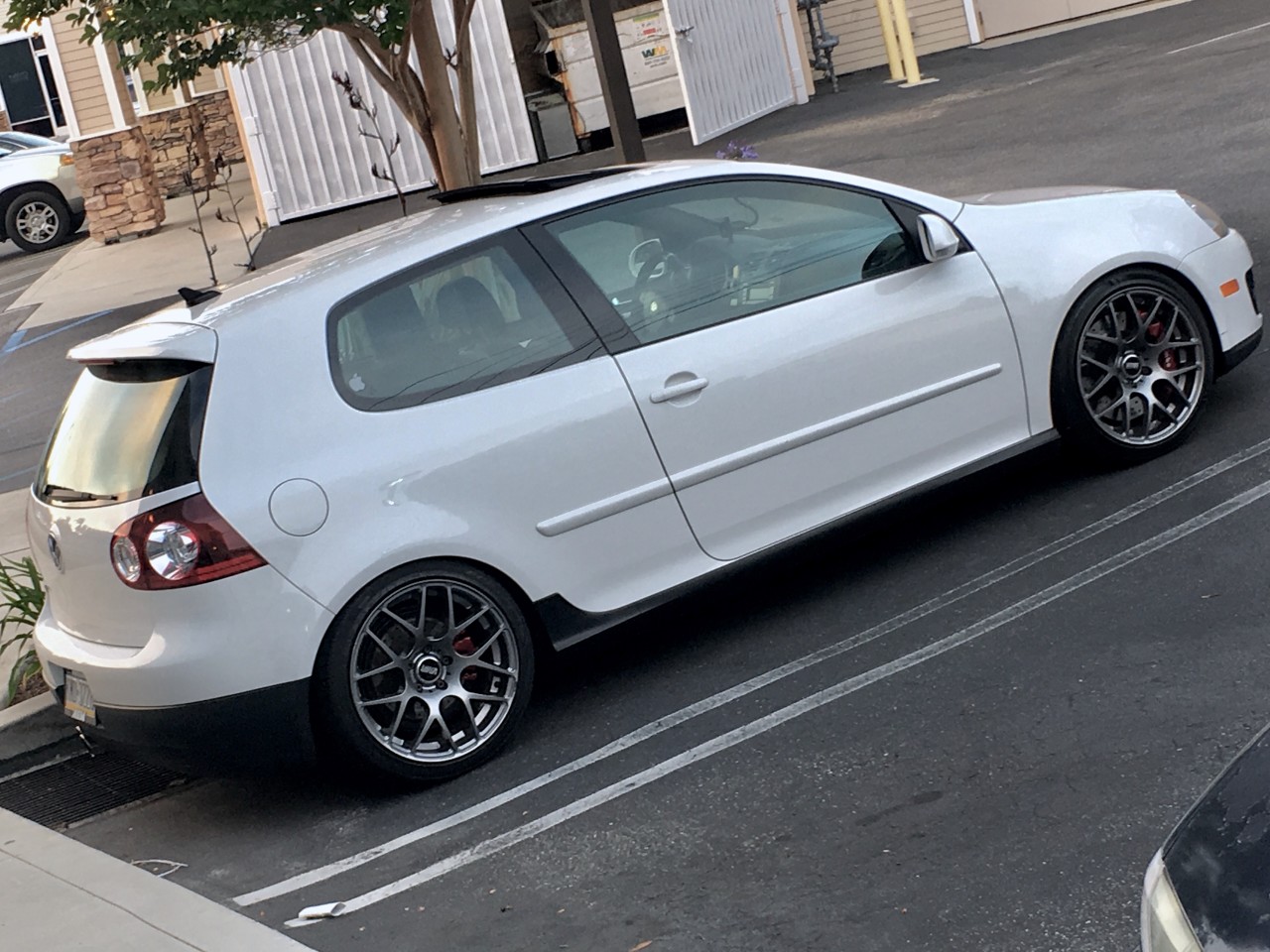
Some closing thoughts:
The braking performance now is just night and day. It's extremely smooth and is super confidence inspiring, the pedal feel is very linear and when you need to stop, the car will absolutely stop. It's one of those things that must be experienced to know the true difference. I am using the stock master cylinder in my car and with the braided lines, I have noticed no difference in pedal droop or mushy pedal. It feels as stiff as the MK7's stock brakes but stops the car so fast it feels like you hit a wall. Overall, these are absolutely wonderful budget big brakes and I can't explain how happy they make me. I receive compliments everywhere I go and the driving feel improvement is fantastic - in my opinion one of the best modifications you can do to your car.
Bleeding brakes is very easy as well, simply follow the bleeding procedure for your vehicle (The MK5 is different, iirc it starts with the caliper closest to the ABS pump). You really only need to use one of the bleeders and you definitely need to use either VAG-COM or OBDEleven to cycle the ABS pump a few times to work bubbles lose. I highly recommend OBDEleven if you have an android phone for other utilities as well.
Concerning the brake rotors, if you go 17Z or 18Z route I highly highly recommend going with the ECS 2-piece rotors, firstly for weight and comfort (crashes harder over bumps with heavier rotors and more unsprung mass), secondly for rotor alignment (The GL450 rotors sit ever so slightly off center between the caliper inside surfaces) and third, the Brembo 18z pads are a bit larger and protrude past the inner diameter of the planar rotor surface. As time goes on, the very ends of the bottoms of the pads will develop a chamfer that makes it more difficult to remove when replacing the pads. It traps the pads a bit. The ECS floating rotors are wide enough to allow the entire pad surface area to sit on the planar rotor surface so that would also not be an issue. There are other floating rotors available at higher prices, so ultimately the choice is yours. As I said I've been using these spiritedly for 8 months so far and they've been fantastic. Here's a shot of them from a few days ago!
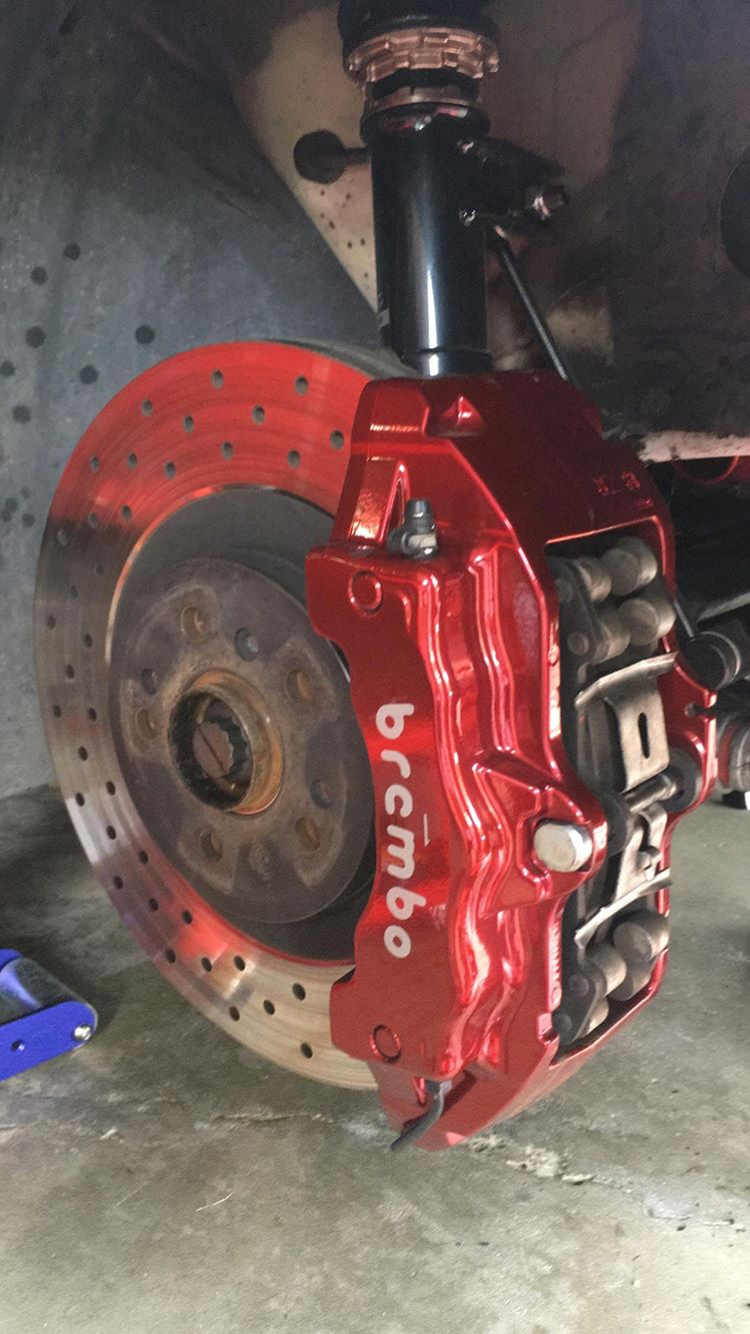
Thanks so much for following along guys and please ask me anything about adding these to your car if you so choose!
Cheers!
8-9-2020
Before buying spacers, here’s the template for the ECS stage 4 kit that uses these calipers. This is for a b5 s4, but it should be similar. If you want I can measure my brakes too.
http://bd8ba3c866c8cbc330ab-7b26c6f3...5_S4_B6_A4.pdf
Also if you want, I have a pair of brand new Ecs +10mm spacers for the fronts. Let me know if you’d like them or not!
Also guys I’m making a few changes and will report back on how it does. As it turns out, I guess I was too spirited with my brake performance drilled rotors because all four are hairline cracked in multiple places.
I’ve opted this time for slotted only rotors from cquence. This time, I’ve opted for ML55 AMG front rotors. The difference with these is that they’re now 345mm instead of 350mm, and 2mm wider which brings the disk to 32mm. This is closer to the OEM SPEC on the stock cayenne rotors (except diameter)
I did a lot of reading and found b5 s4 guys having trouble with the GL450 rotors and 18z sized pads creating that weird chamfer lip. So what I’ve done is I’ve ordered 17Z duralast gold pads (the brembo ceramic 18z pads I had on the front are a bit dusty and stupid loud, I cannot get them to be quiet. And for the price of just the two front pads for both calipers approaching $200, I just can’t and don’t want to. Cheapos are going in this time)
I’ve already test fitted the 17z pads and I can say they overhang a lot less and will work perfectly with the ML55 rotors. They’re the same width as the 18z so it’s a direct fit. A few s4 guys apparently use this trick to prevent the weird chamfer situation. I’ll post pictures of them on the car soon! Currently the car is apart with the engine out for chain and clutch upgrades, and I’m thinking of making a DIY for pulling the engine. Might be my next one.
Stay tuned!